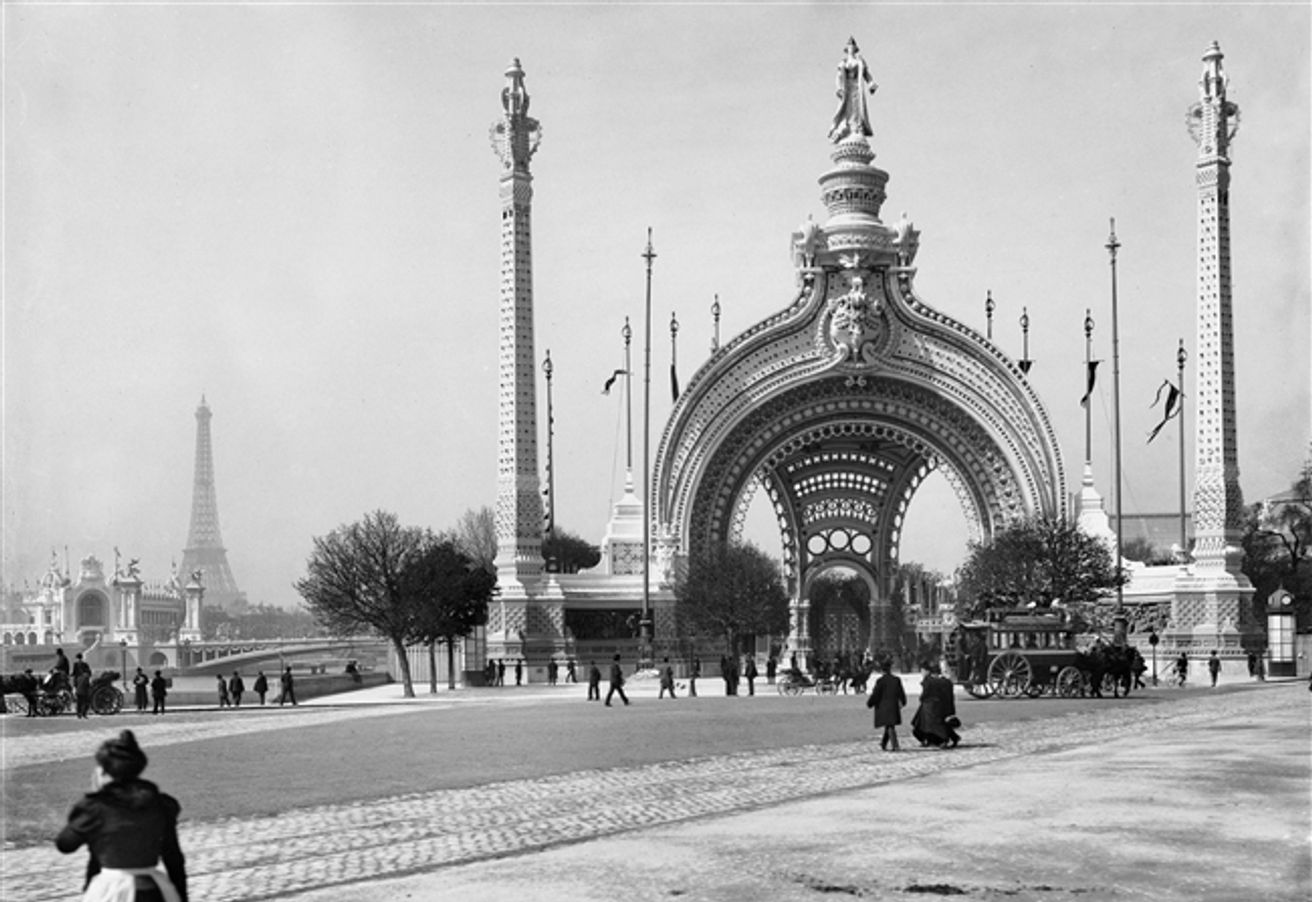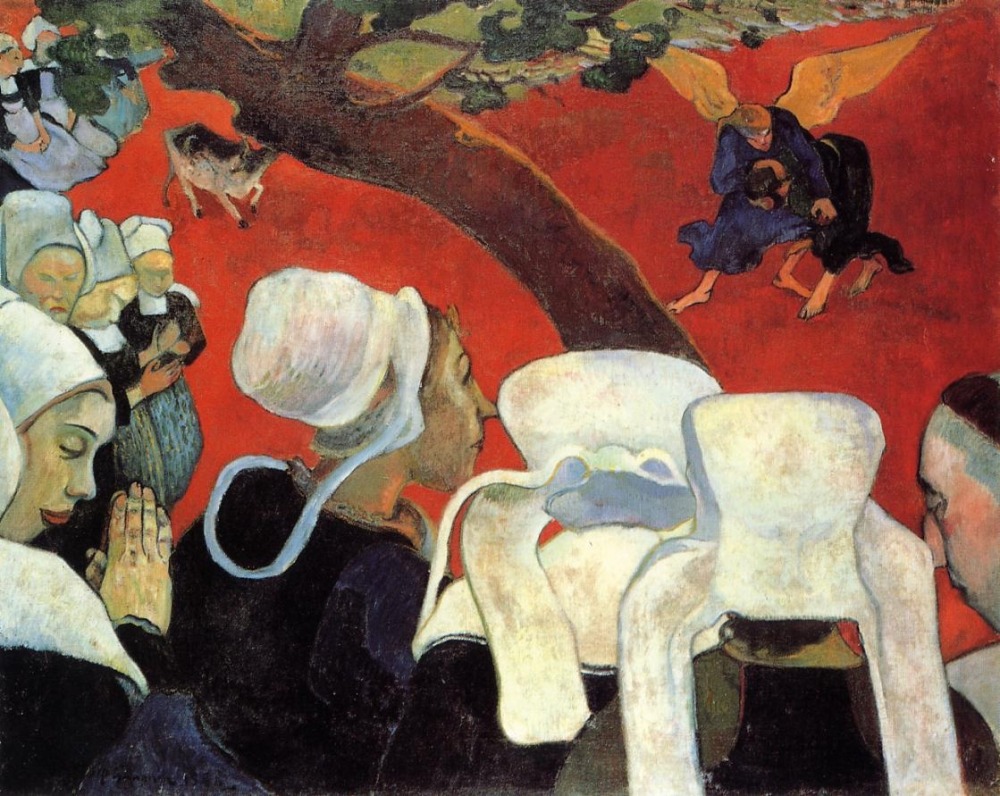RADIUM AGE ART (1900)
By:
January 6, 2024
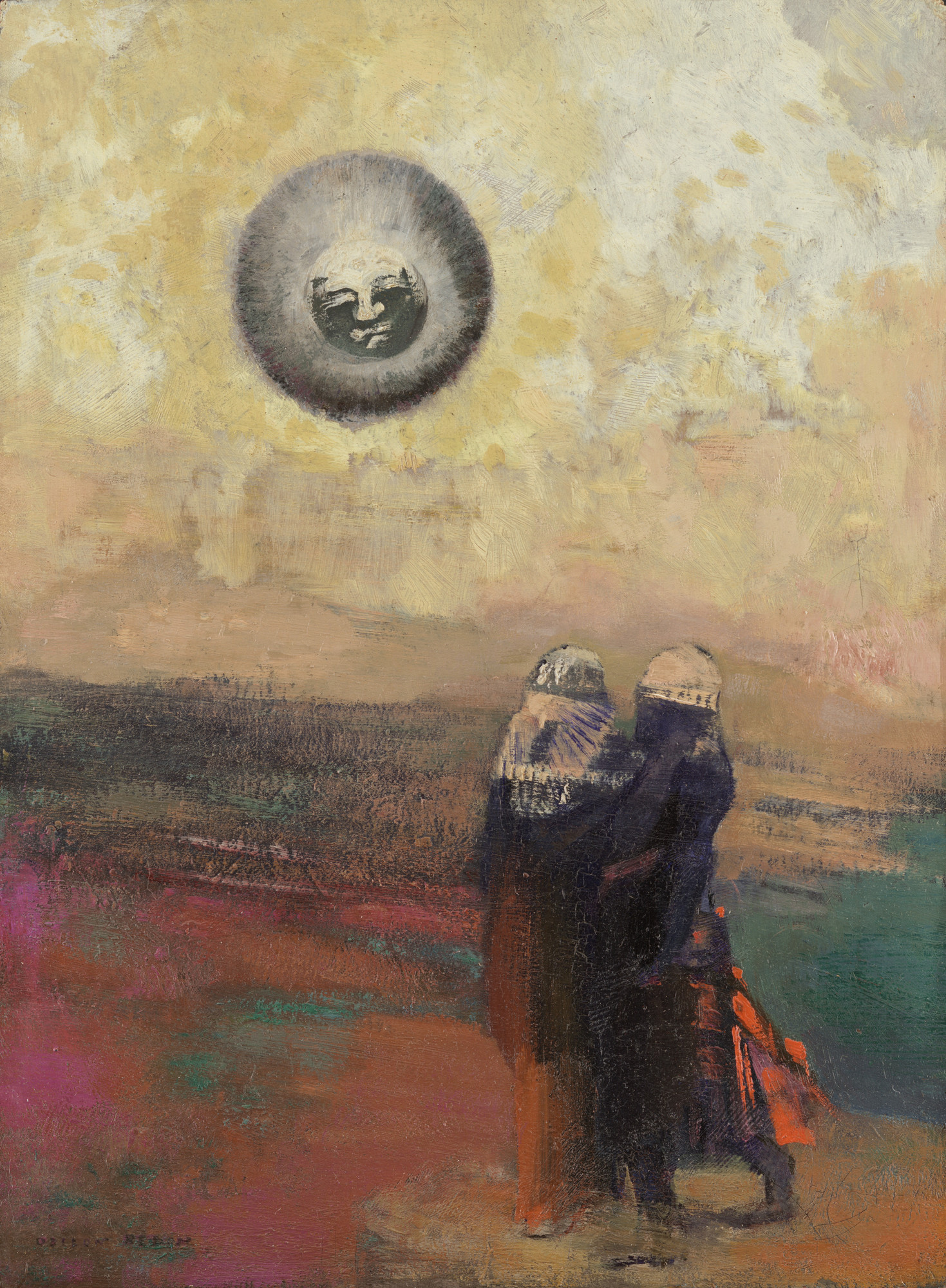
A series of notes regarding proto sf-adjacent artwork created during the sf genre’s emergent Radium Age (1900–1935). Very much a work-in-progress. Curation and categorization by Josh Glenn, whose notes are rough-and-ready — and in some cases, no doubt, improperly attributed. Also see these series: RADIUM AGE TIMELINE and RADIUM AGE POETRY.
RADIUM AGE ART: 1900 | 1901 | 1902 | 1903 | 1904 | 1905 | 1906 | 1907 | 1908 | 1909 | 1910 | 1911 | 1912 | 1913 | 1914 | 1915 | 1916 | 1917 | 1918 | 1919 | 1920 | 1921 | 1922 | 1923 | 1924 | 1925 | 1926 | 1927 | 1928 | 1929 | 1930 | 1931 | 1932 | 1933 | 1934 | 1935 | THEMATIC INDEX.
Please note that in my periodization schema, the years 1900–1903 are an interregnum of sorts, during which the seeds of science fiction’s Radium Age were planted. Thus, while artwork from this year (1900) may hint at the Radium Age proto-sf adjacent artwork to come, it may not exactly be something I’d want to describe with certainty as “Radium Age art.”
Twentieth-century life: the disintegration of social forms; the shocks of modern, high-tech warfare; the abandonment of established religions; the incomprehensibility of new scientific and mathematical theories and discoveries.
The 20th century opens with a World’s Fair attracting some 50 million visitors, from around the world, to the Champ-de-Mars in Paris. In Paris’s Petit Palais, the Impressionists have their official triumph. One of the largest palaces, lit by more than ten thousand light bulbs, is dedicated to demonstrating electricity.
Already, a decade and a half before the mechanized catastrophe of WWI, anti-positivist artists are beginning to counter modern positivism and modernity — what Max Weber called “the disenchantment of the world,” meaning secularization and the decline of magic with the escalation and intensification of capitalist utilitarianism, intellectualization and scientific, bureaucratic, legal and political rationalism under the banner of “progress.” To the extent that the Impressionists are associated with positivism, these avant-garde artists are anti-Impressionist.
Cf. Jules Laforgue’s 1883 catalog essay for an impressionist exhibit, which suggests that the impressionists’ dynamic brushwork make visible the microscopic variations of color; he is alluding to the Newtonian theory that light consists of waves in an all-pervasive ether. The waves, as such, are imperceptible to the naked eye: what we perceive are the colors corresponding to different wavelengths.
Post-Impressionism is usually dated from 1886 and 1905, i.e., from the last Impressionist exhibition up to the birth of Fauvism. It was made famous by the works of Cézanne, Seurat, Van Gogh, and others who focused on extending the limitations of Impressionism by investigating techniques that would allow them to gain a purer form of expression — while, in most cases, retaining Impressionism’s use of bright and fantastic colors displayed with short brushstrokes.
Note: The French chemist Michel Eugène Chevreul, a founder of modern organic chemistry, was for some time in the early 19th century director of the Gobelins Manufactory in Paris. There he discovered the effect he named “simultaneous contrast,” defining it as the tendency for a color to appear to shift toward the complementary of its neighbor, both in terms of hue and darkness. He explored the ramifications of the concept at book-length in 1839, which would influence Impressionist and Neo-Impressionist painting — particularly the Pointillist style developed by Georges Seurat and Paul Signac, which featured tiny juxtapositions of complementary colors. In the 20th century, Jean Metzinger would introduce Robert Delaunay to Chevreul’s theories. Delaunay’s style of mixing relatively large blocks of near-complementaries was dubbed “Orphism,” though Delaunay himself preferred the name “Simultanism,” a nod to Chevreul.
From the book MoMA Highlights: 350 Works from the Museum of Modern Art New York (second edition, 2004).
Georges Seurat had used his readings of optical theory to develop a systematic technique — pointillism — that involved the creation of form out of small dots of pure color. In the viewer’s eyes, these dots can both coalesce into shapes and remain separate particles, generating a magical shimmer.
A few years prior to this: In 1892 the German journal Jugend was founded and in Germany Art Nouveau was called “Jugendstil.” August Endell’s 1896 pamphlet caused a stir by insisting: “The greatest mistake one can make is to believe that Art is the precise reproduction of Nature.” Endell was inspired by the bold abstract carpet designs, drawings, and sculptures of Hermann Obrist. Both artists would directly influence Kandinsky.
Kandinsky and Paul Klee are students at the Royal Academy in Munich.
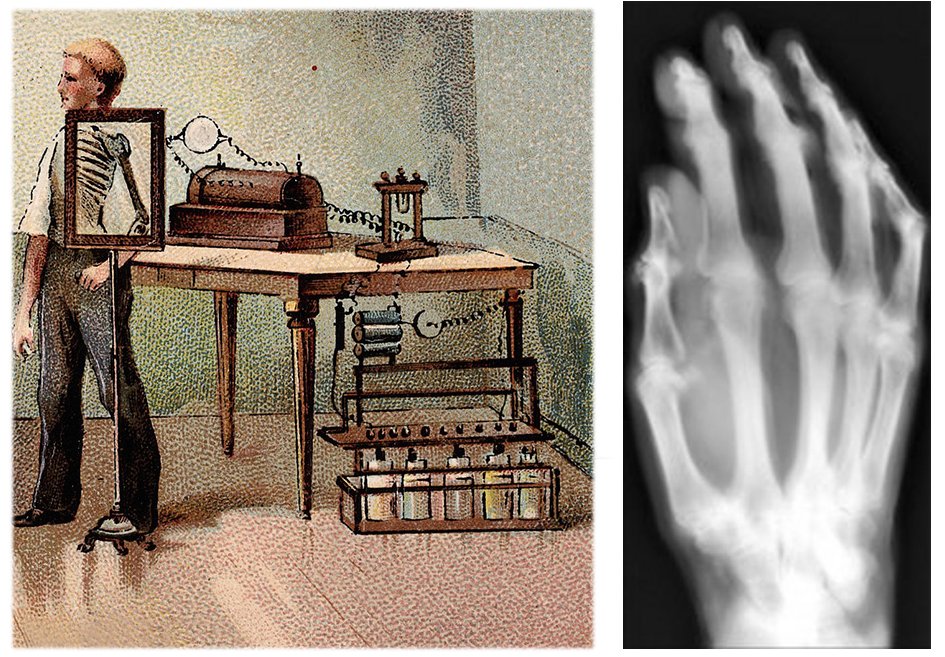
At the 1900 Exposition Universelle in Paris, x-ray photographs and equipment are exhibited. This was the first European World’s Fair to be lit exclusively by electric light. Enormous boilers and dynamos from German, English, and French manufacturers filled a pair of factory halls, providing the current for the fair.
In L’Inconnu (1900), the astronomer Camille Flammarion uses the discovery of x rays in his argument for the scientific legitimacy of researches into the unknown.” (Quoted in Henderson.)
At the first International Congress of Philosophy, held in Paris in 1900, Henri Bergson reads a short, but important, paper, “Psychological Origins of the Belief in the Law of Causality.” Also in 1900, Bergson’s book Laughter appears. Its passages dealing with the place of the artistic in life would be influential on several artists.
Aleister Crowley initiated into the Hermetic Order of the Golden Dawn. “When Crowley showed a tendency to use his occult powers for evil rather than for good,” Ellmann writes, “the adepts of the order, Yeats among them, decided not to allow him to be initiated into the inner circle; they feared that he would profane the mysteries and unleash powerful magic forces against humanity.” Crowley’s ouster lead to a spell-chanting confrontation in 1900 known as “the Battle of Blythe Road.” The occult organization would be dissolved in 1903; it fragmented into Alpha et Omega, the Stella Matutina (W.B. Yeats remained active in this sect, until it dissolved in 1922), the Isis-Urania Temple (led by A. E. Waite and others), and Aleister Crowley’s A∴A∴.
Second Boer War (October 1899 – 31 May 1902) raging. Britain — which boasted the world’s most technologically advanced military — expected a swift victory against a mostly unmilitarized and predominantly agricultural-based opponent. However, the conflict dragged on into the 20th century, causing many both domestically and internationally to question the dominance of the British Empire.
The so-called Boxer Rebellion, an anti-foreign, anti-imperialist, and anti-Christian uprising in North China, led by the Society of the Righteous and Harmonious Fists, rages between 1899 and 1901. The events of the rebellion influenced the idea of the Yellow Peril among the British public. (The racist phrase “yellow peril” blends Western anxieties about sex, racist fears of the alien Other, and the Spenglerian belief that the West will become outnumbered and enslaved by the East.)
The Exposition Universelle opens in Paris. Many technological innovations were displayed at the Fair, including the Grande Roue de Paris ferris wheel, the Rue de l’Avenir moving sidewalk, the first ever regular passenger trolleybus line, escalators, diesel engines, electric cars, dry cell batteries, electric fire engines, talking films, anf the telegraphone (the first magnetic audio recorder). Henry Adams visited the Hall of Electrical Machines, where he fixated on one of the gigantic dynamos on display. Its size and mechanism, he wrote, its “huge wheel, revolving within arm’s-length at some vertiginous speed” while making hardly a sound, were an unfathomable, but seductive, mystery — one that left him in awe, but worried about the human spirit in the new Age of the Machine.
The first zeppelin airship flight, by Ferdinand Zeppelin’s Zeppelin LZ 1 is carried out over Lake Constance, near Friedrichshafen, Germany.
Max Planck announces his discovery of the law of black body emission, marking the birth of quantum physics.
Freud’s Interpretation of Dreams.
Also see: RADIUM AGE: 1900
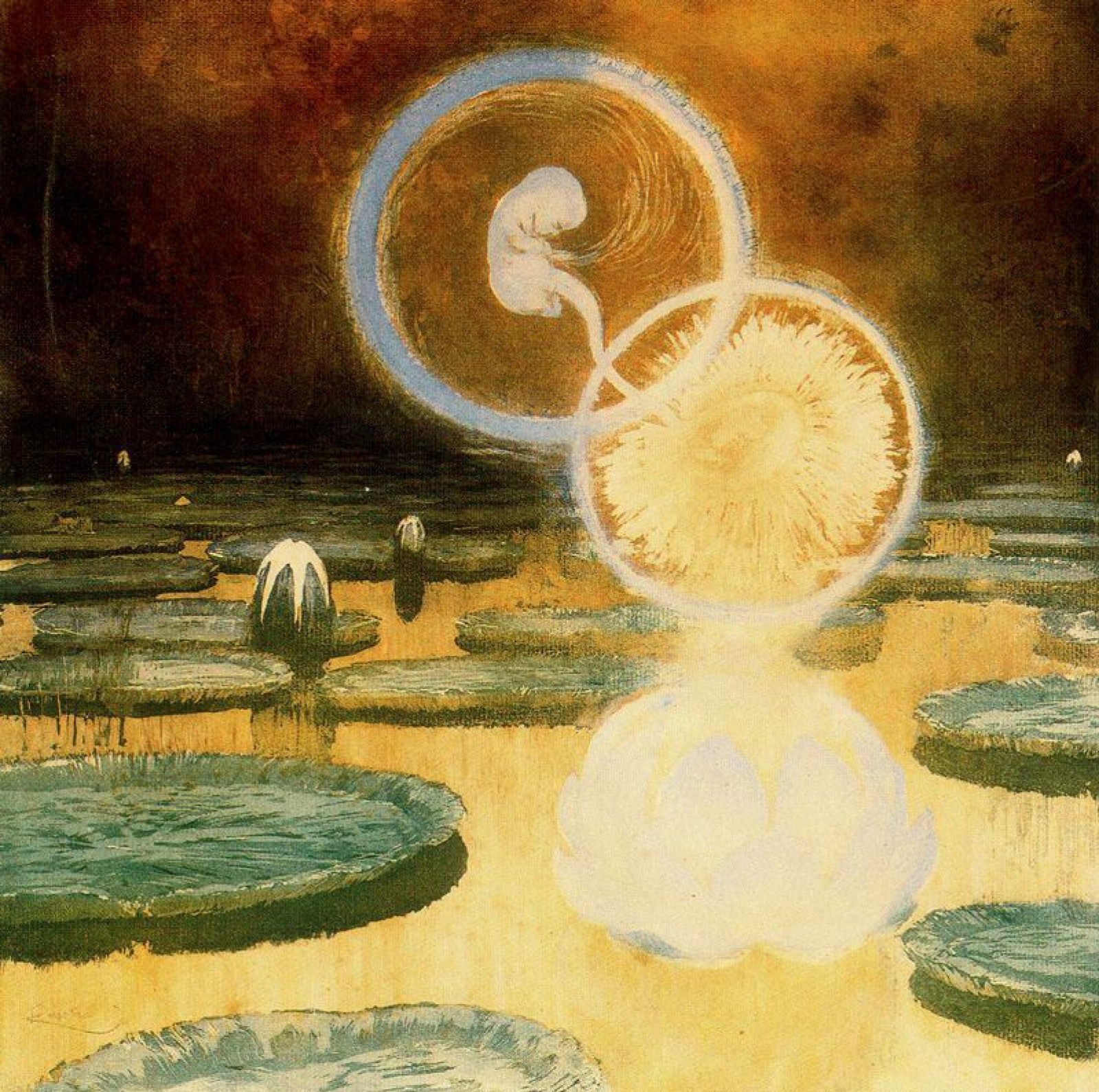
Symbolist Czech painter František Kupka (1871-1957), who spent his active years in Paris, “remains one of the most under-researched artists, given his important status as one of the first painters of totally abstract works of art, beginning in 1912.” — Chelsea Ann Jones, The Role of Buddhism, Theosophy, and Science in František Kupka’s Search for the Immaterial Through 1909 (2012).
Buddhism, Theosophy, and science too — during this era — helped certain artists conceive of an immaterial, invisible reality that could only be depicted symbolically.
As a youth, Kupka was introduced to spiritualism. He developed into a talented spirit medium, one hears, before studying art (as a teenager) with Alois Strudnica, who was interested in ornamental abstraction, and had his students draw and work with geometric forms. Strudnica introduced Kupka to the Nazarenes, an early 19th-century art movement that wanted to return art to the spirituality of the late medieval German artists, and who believed that contemplation (inner — not outer) should be a principal source of artistic inspiration. Kupka’s early work would (we read at MoMa’s website) “explore the relationship between religion, color, and geometry.”
Here in 1900 we find Kupka poised at a pre-abstraction moment, seeking ways to express through representational art that which that representational art cannot express. Working in a Symbolist vein, he believed that the painting of objects from nature (trees, say) was fruitless when one could see “better ones in reality” — why strive for realism? Starting around 1905, as we’ll see later on in this series, Kupka’s work would become increasingly abstract, concentrating on color and motion.
Pepe Karmel notes that the popularity of the embryo/fetus motif as a symbol of spiritual rebirth reflects the influence of German biologist Ernst Haeckel’s famous 1870s diagram of comparative embryological development. Haeckel argued that diverse speies began as virtually identical embryos and recapitulated their evolutionary histories in utero before assuming their different mature forms. He seems to have fudged the evidence, making the embryos look more similar than they actually are, but it was a powerful visual argument for the oneness of all living creatures.
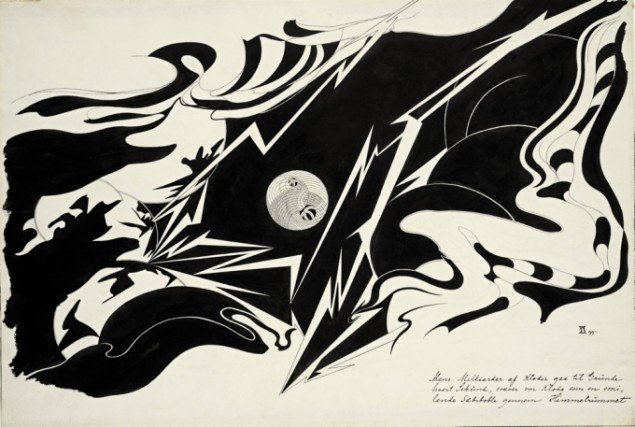
Complete title: “While billions of planets are collapsing every second, our planet floats around like a smiling soap bubble through the sky.”
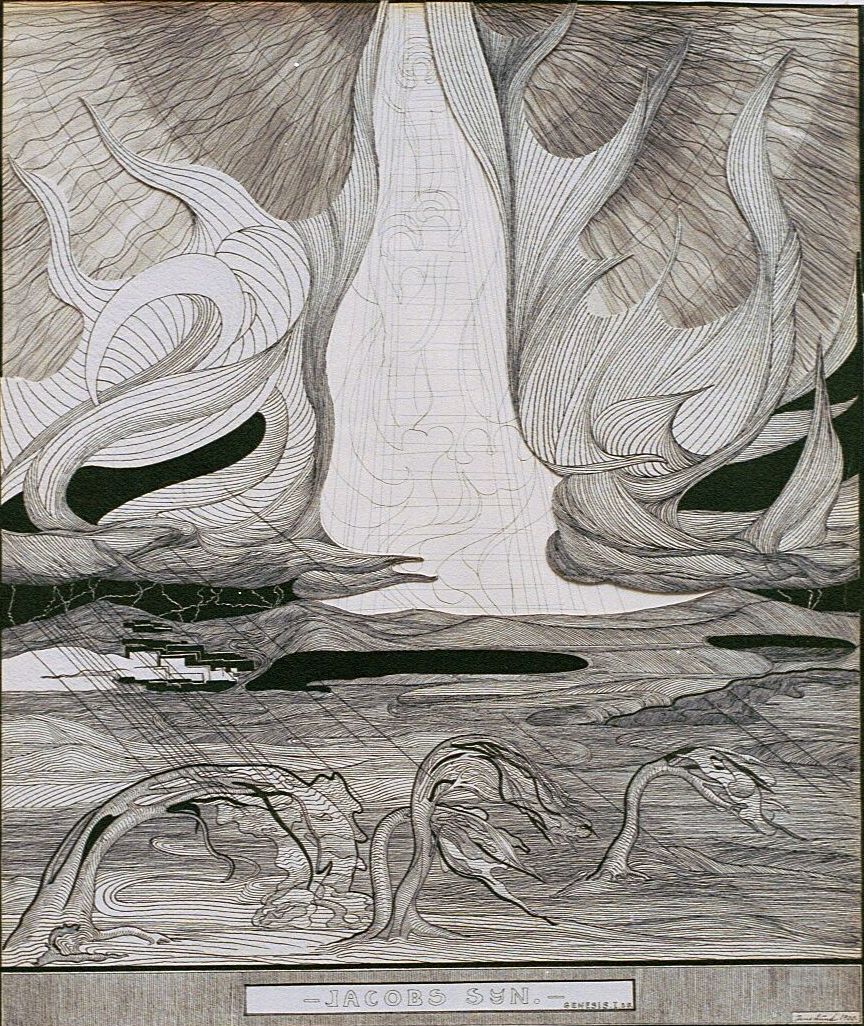
Throughout his work, Lund attempted to forge a connection between writing and graphic expression; publishing two works with text to advance his goal: Livets Skov (1901) and Forvandlede Blomster (1899). Asger Jorn considered some of his early works to be forerunners of Surrealism.
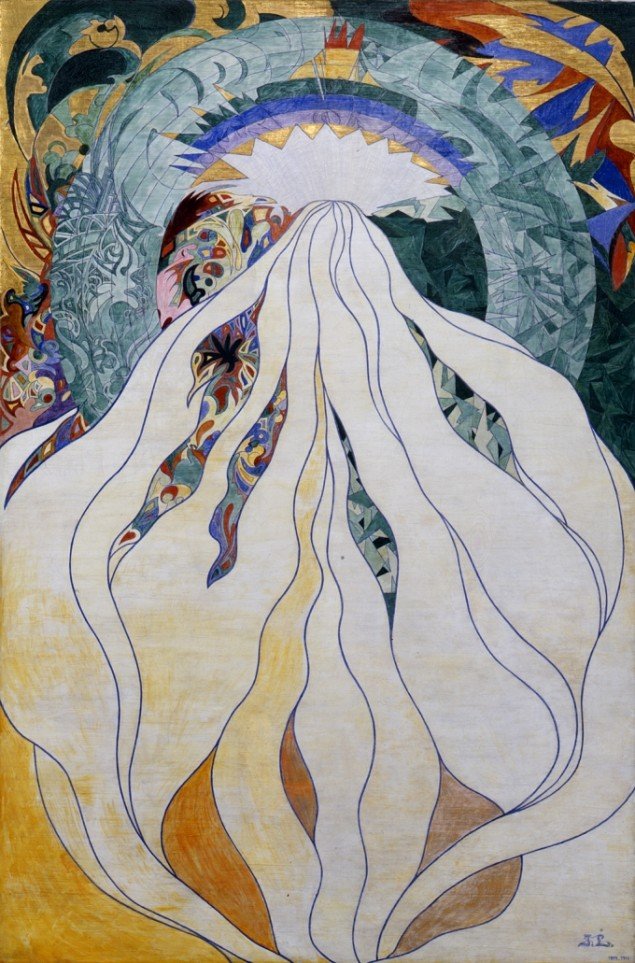
Smartify has the following to say: “In 1899-1900 the Danish symbolist draftsman and painter Jens Lund created an abstract image of something larger than us, a connection between earth and heaven visualized as tentacles/flames/roots from below and into the green portal. Like the two sides of the yin and yang he has depicted two worlds within the perfect circle — on the right all is dark with spiky, vicious-looking objects like broken glass, as opposed to the colorful, rounded friendly looking shapes on the left side. When exhibiting the painting in Copenhagen, Denmark, in 1901 he noted that it was a study for a stained glass window. It was never made…”
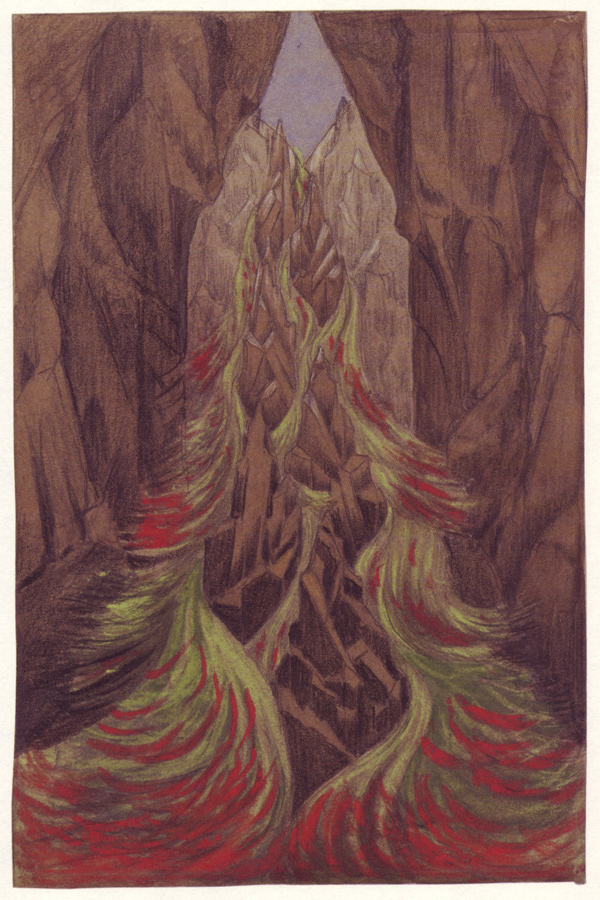
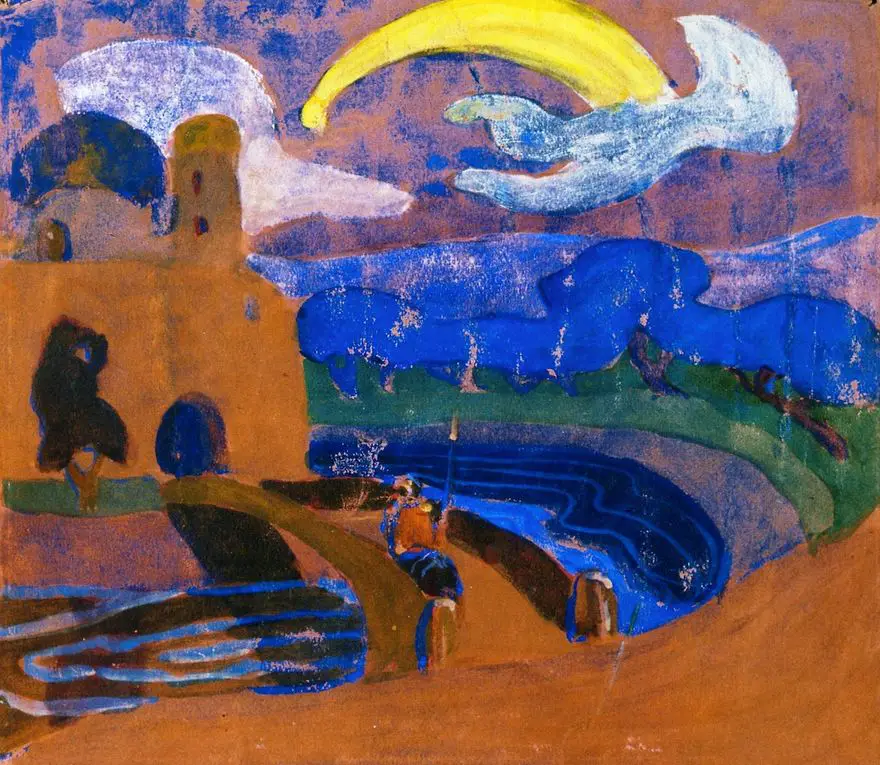
Kandinsky’s decision — in 1896 — to leave Moscow and his law career there for Munich, to follow his vision of a new mode of art that would explore a world of contradiction and inconsistency, was driven by three “shattering” and challenging experiences / revelations (he’d later recount). One was the exhibition of French Impressionists in Moscow, and Monet’s Haystack in particular. The second was seeing Wagner’s Lohengrin and vividly imagining abstract artworks inspired by the music. The third was the well-publicized discovery of X-rays in 1895 (by Röntgen) and radioactivity in 1896 (by Becquerel and Marie Curie), which shook the foundations of the scientific conception of the world at the time, which led immediately to speculation about the existence of subatomic particles. In Kandinsky’s memoir: “In my soul the decay of the atom was the same as the decay of the whole world. Suddenly the sturdiest walls collapsed. Everything become uncertain, unsteady [wobbly], and soft. It would not have amazed me, if a stone had melted into air before me and become invisible.” (Quoted without attribution in Hajo Düchting’s Wassily Kandinsky, 1866-1944: A Revolution in Painting.
Note: When it comes to landscapes, Impressionism was a more abstract version of landscape painting. It “dematerialized the physical world,” as Pepe Karmel puts it, “into a vibrating scrim of optical sensations.” Paintings like Monet’s “Morning on the Seine near Giverny” (1897) flatten three-dimensional landscape into an abstract pattern. This sort of analysis helps me to understand Impressionism’s influence on the pioneers of abstract painting.
More from Kandinsky’s memoir: “Science seemed to me destroyed: its most important basis was only a madness, a mistake of the scholars, who were not building a divine structure stone by stone but were rather groping about randomly in darkness for truths…”
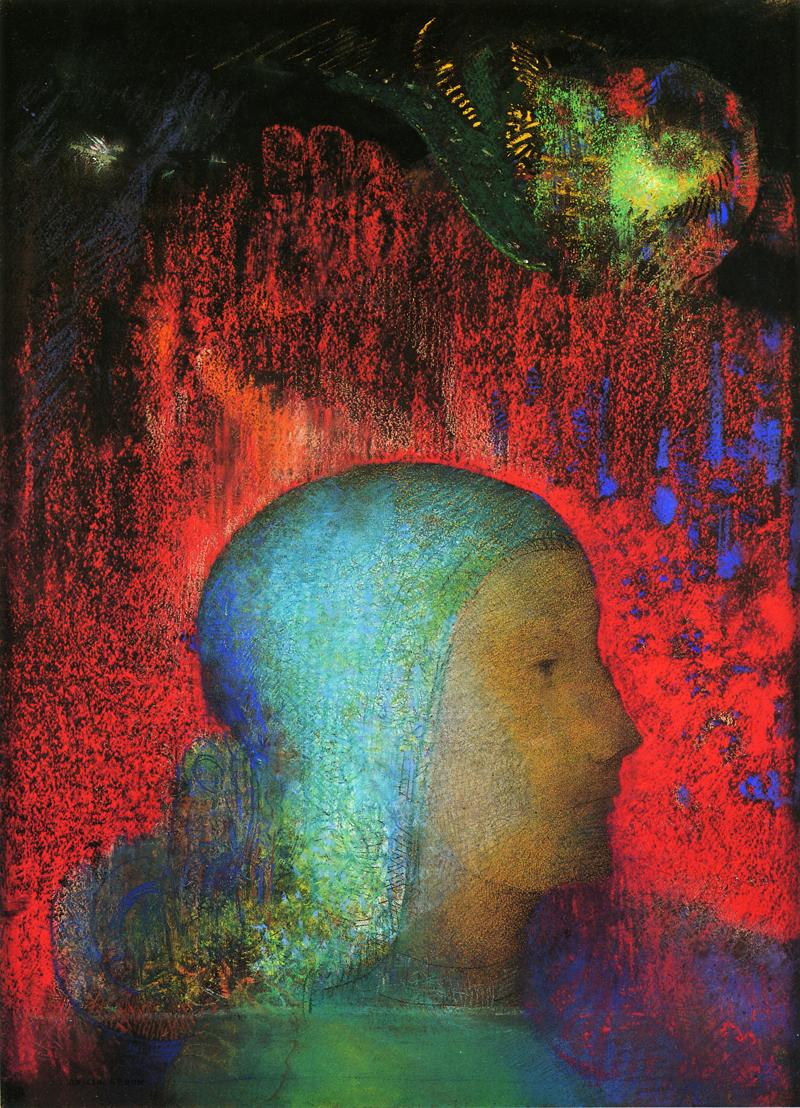
See below for an example of this artwork used for an sf book cover illustration.
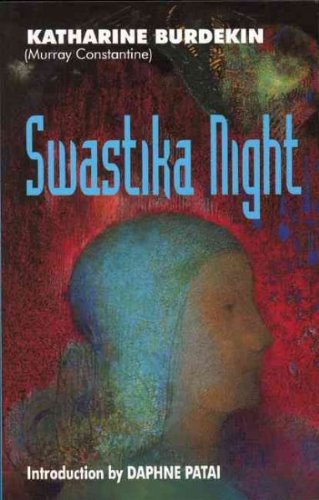
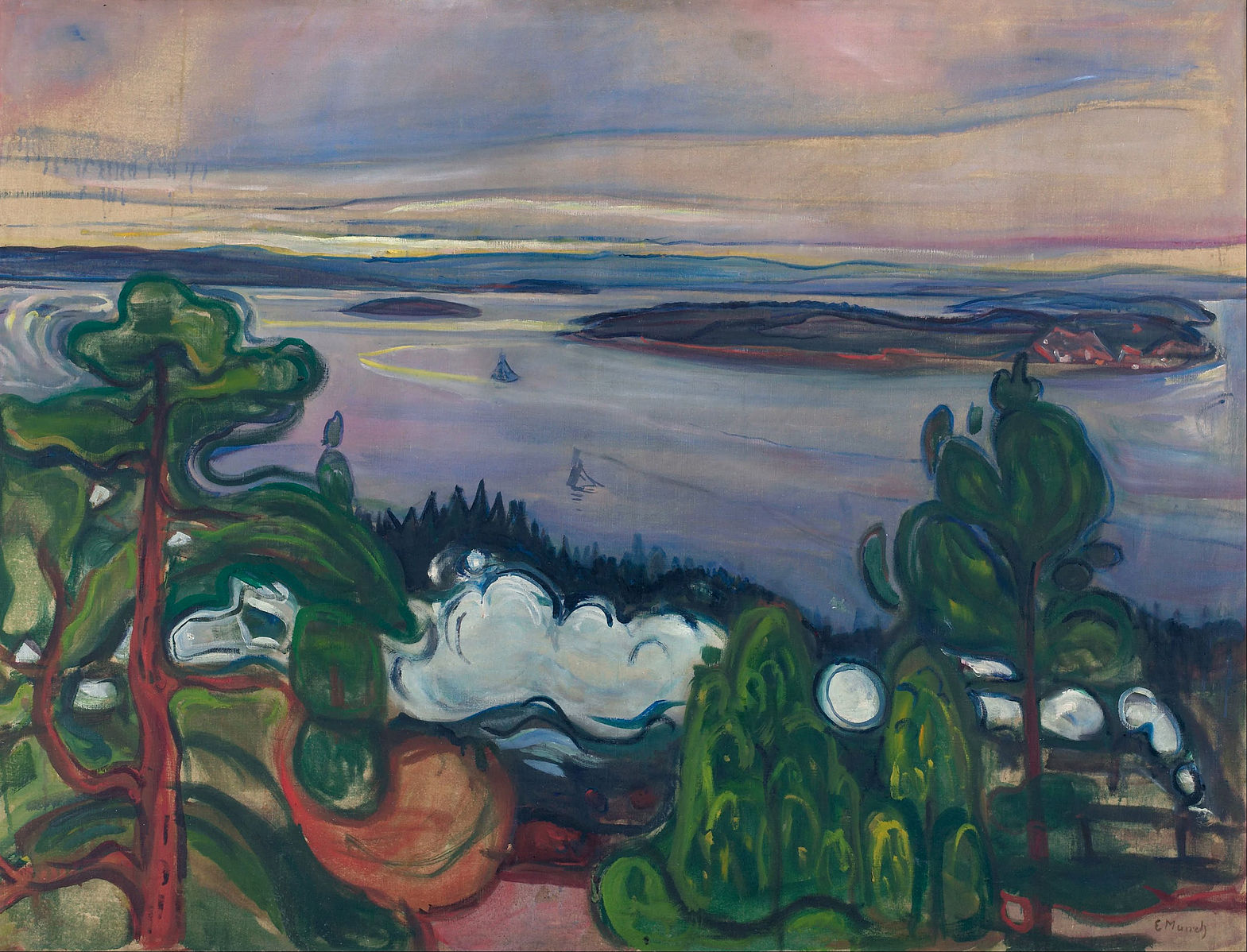
Movement: Expressionism? Art Nouveau?
Seven years after producing The Scream, Munch continues to seek an answer to the question (as articulated by Annemarie Iker at MoMA’s website), “to what extent can artists convey their innermost thoughts and feelings using lines, forms, and colors?”
We can barely spot the train — just the smoke, which the artist renders in “simplified, rounded shapes, defined and limited by clear contour lines” (source TBD). Peter Schjeldahl notes that Munch changes painting style within this painting, at the treeline in the middle ground.
Munch was closely associated with Symbolist circles, spending time in Paris before settling in Germany in the early 1890s. His intensely personal style is often referred to as Symbolic Naturalism as his subjects are not exotic or fantastical but based on the real anxieties of modern existence. Virtually all of the canvases he produced between 1893 and 1902 belong to a series called the Frieze of Life.
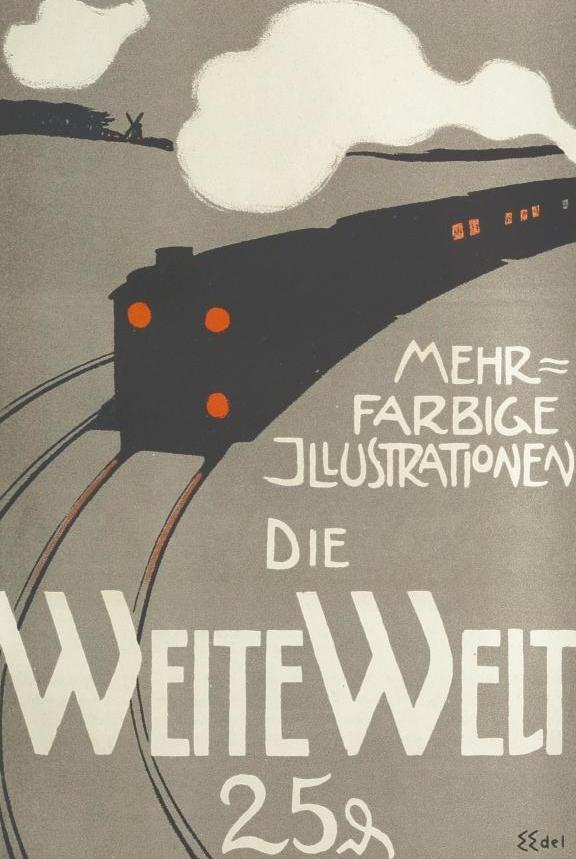
Also see The Railway: Art in the Age of Steam (2008)?
“Enthusiasm for Art Nouveau reached its epitome at the great world’s fair of 1900, the Exposition Universelle in Paris, where René Binet modeled the multi-story main entrance to the fair on the form of microscopic radiolaria (a creature with a striking crystalline exoskeleton).” — Lynn Gamwell, Beyond the Visible–Microscopy, Nature, and Art (2003).
Binet modeled that main entrance after an illustration of Clathrocanium reginae by Ernst Haeckel.
See: “Protoplasmania: Huxley, Haeckel, and the vibratory organism in late nineteenth-century science and art,” by Robert Michael Brain (2009).
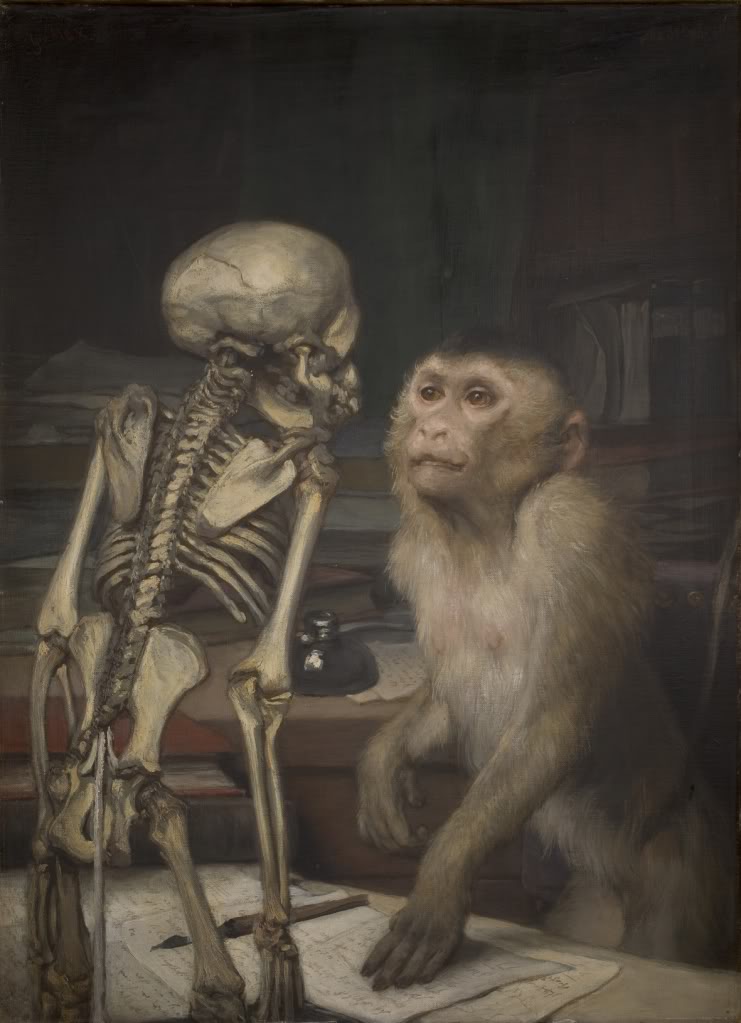
Gabriel von Max (1840–1915) was a Prague-born Austrian painter, professor of history painting, and a collector of anthropological artifacts. His studies included parapsychology (somnambulism, hypnotism, spiritism), Darwinism, Asiatic philosophy, the ideas of Schopenhauer, and various mystical traditions.
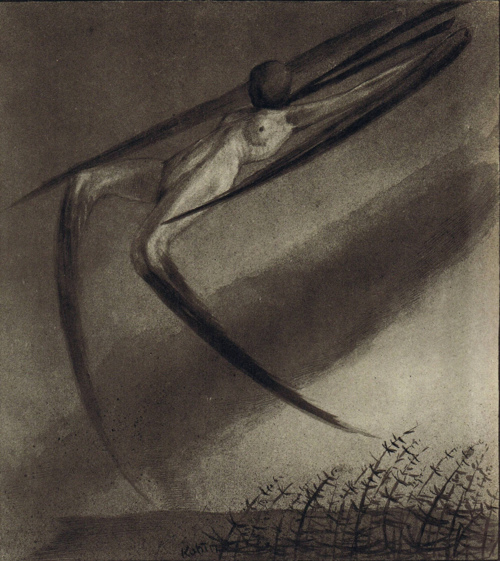
Alfred Kubin (1877 – 1959) was an Austrian printmaker and illustrator (or Poe, Hoffmann, etc.). He is considered an important representative of Symbolism and Expressionism. In Munich, c. 1899, he discovered the works of Odilon Redon, Edvard Munch, James Ensor, Henry de Groux, and Félicien Rops. In 1911, he became briefly associated with the Blaue Reiter group. Kubin also illustrated the German fantasy magazine Der Orchideengarten.
His only literary work was Die andere Seite (The Other Side, 1908), a fantastic novel set in an oppressive imaginary land.The novel has an atmosphere of claustrophobic absurdity similar to the writings of Kafka, who admired Kubin’s book.
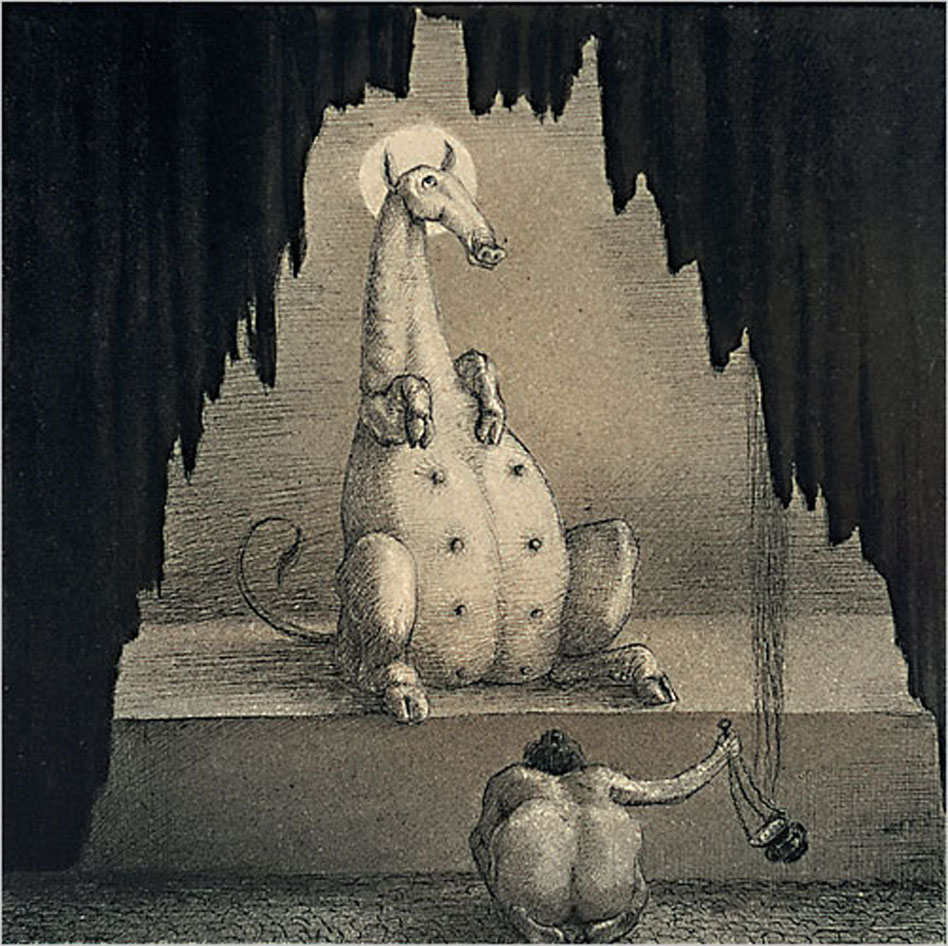
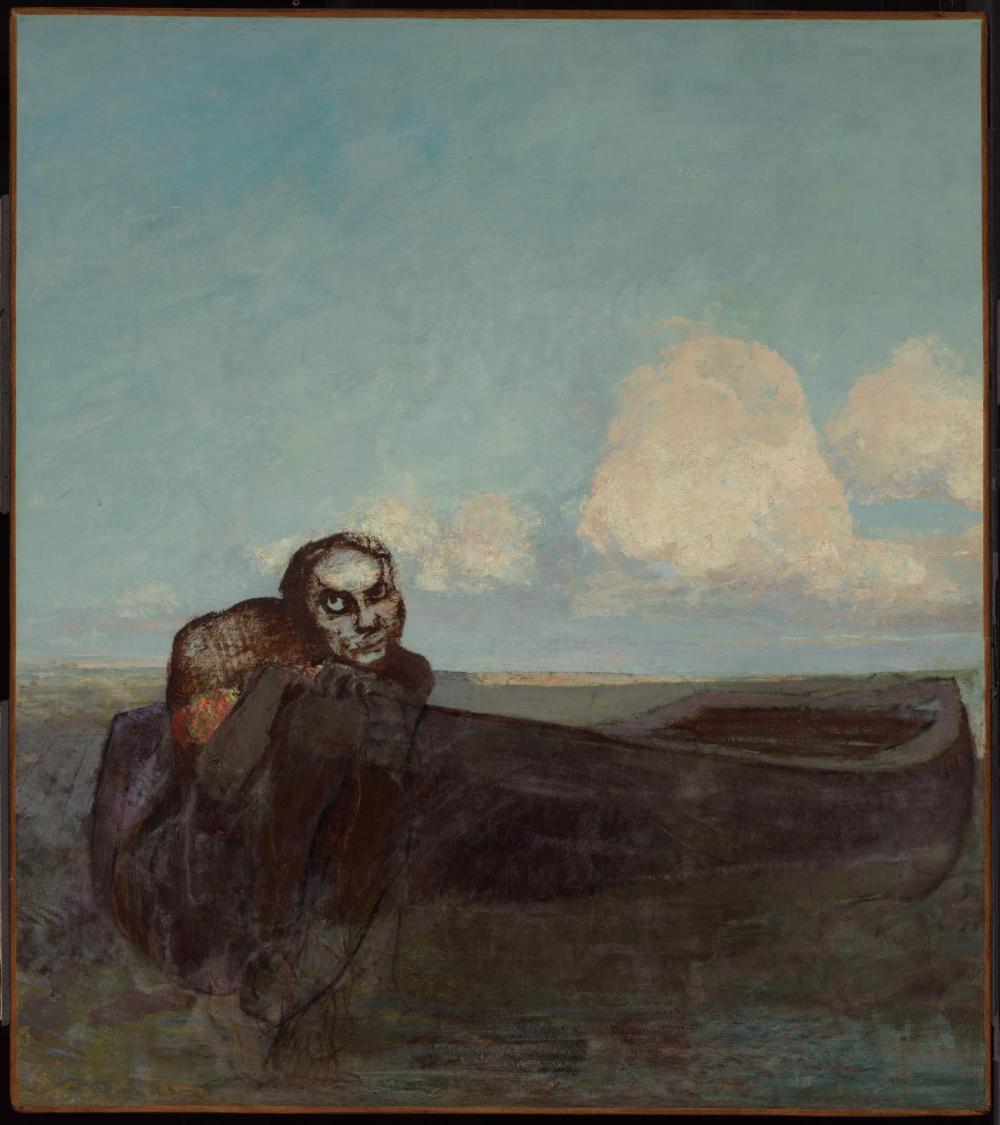
See below for an example of this artwork used for an sf book cover illustration.
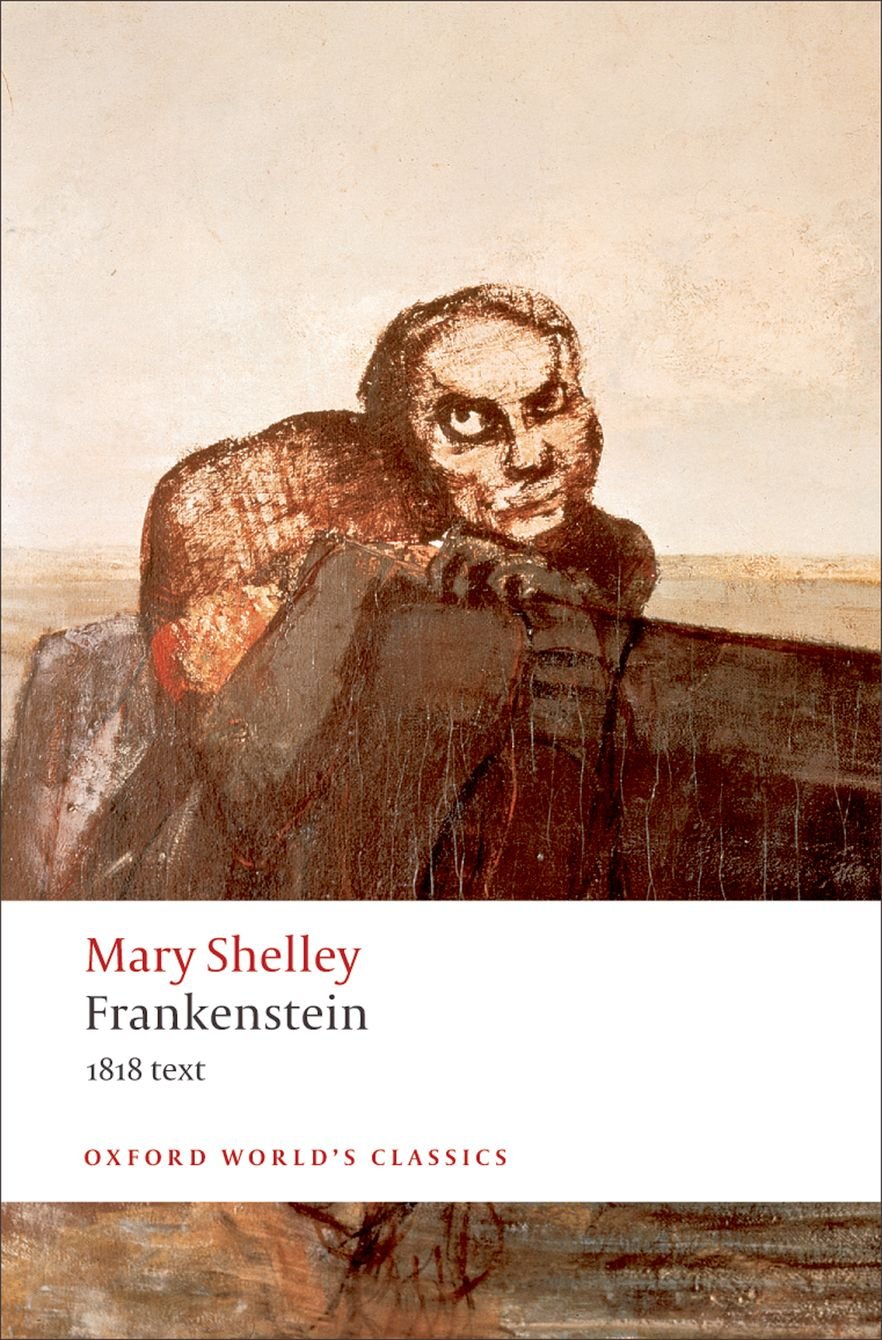
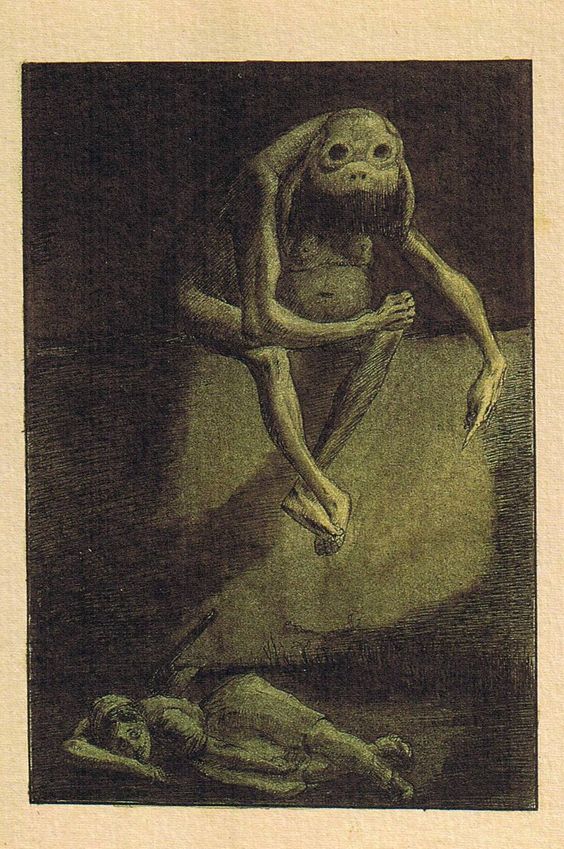
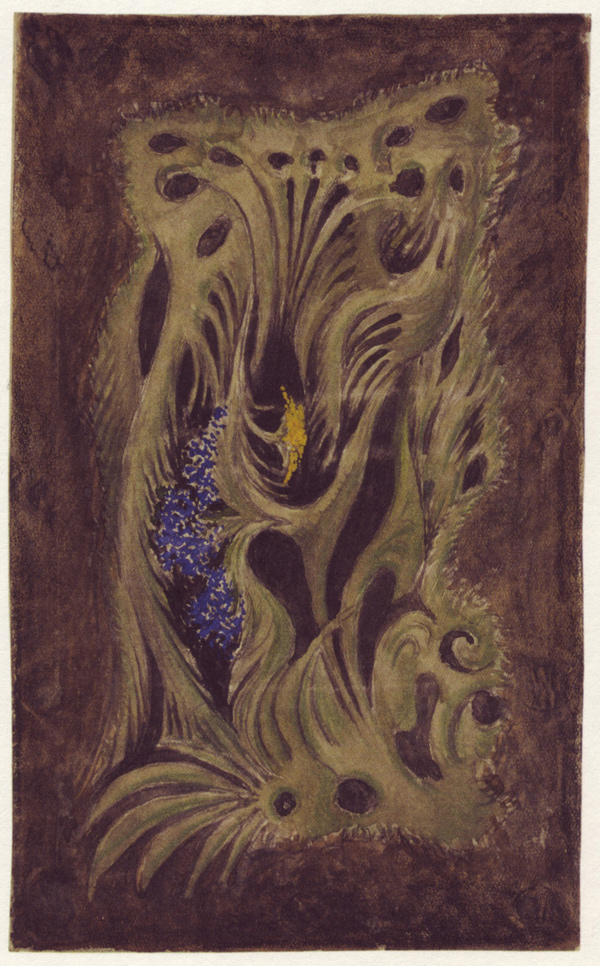
Also see: Hermann Obrist – Sculpture, Space, Abstraction around 1900.
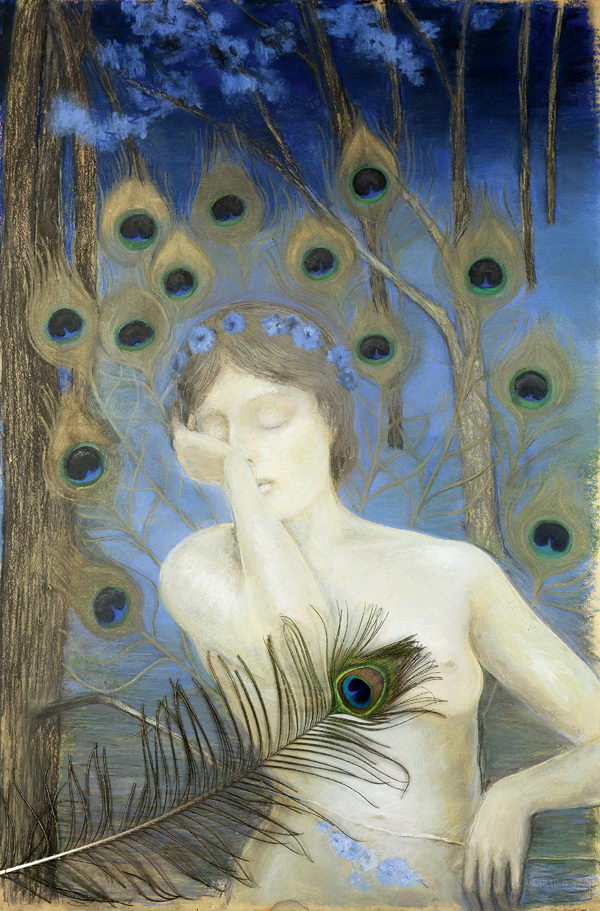
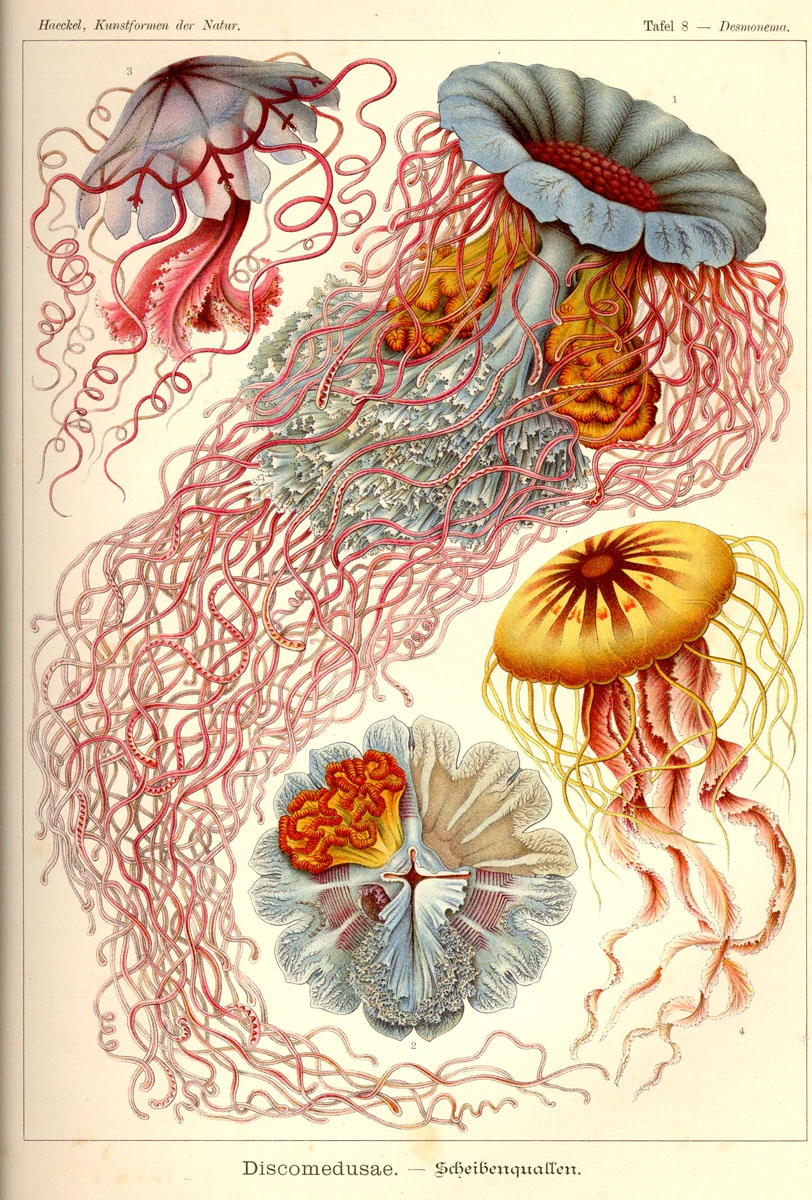
Kunstformen der Natur (Art Forms in Nature) is a book of lithographic and halftone prints by the German biologist Ernst Haeckel, originally published in sets of ten between 1899 and 1904.
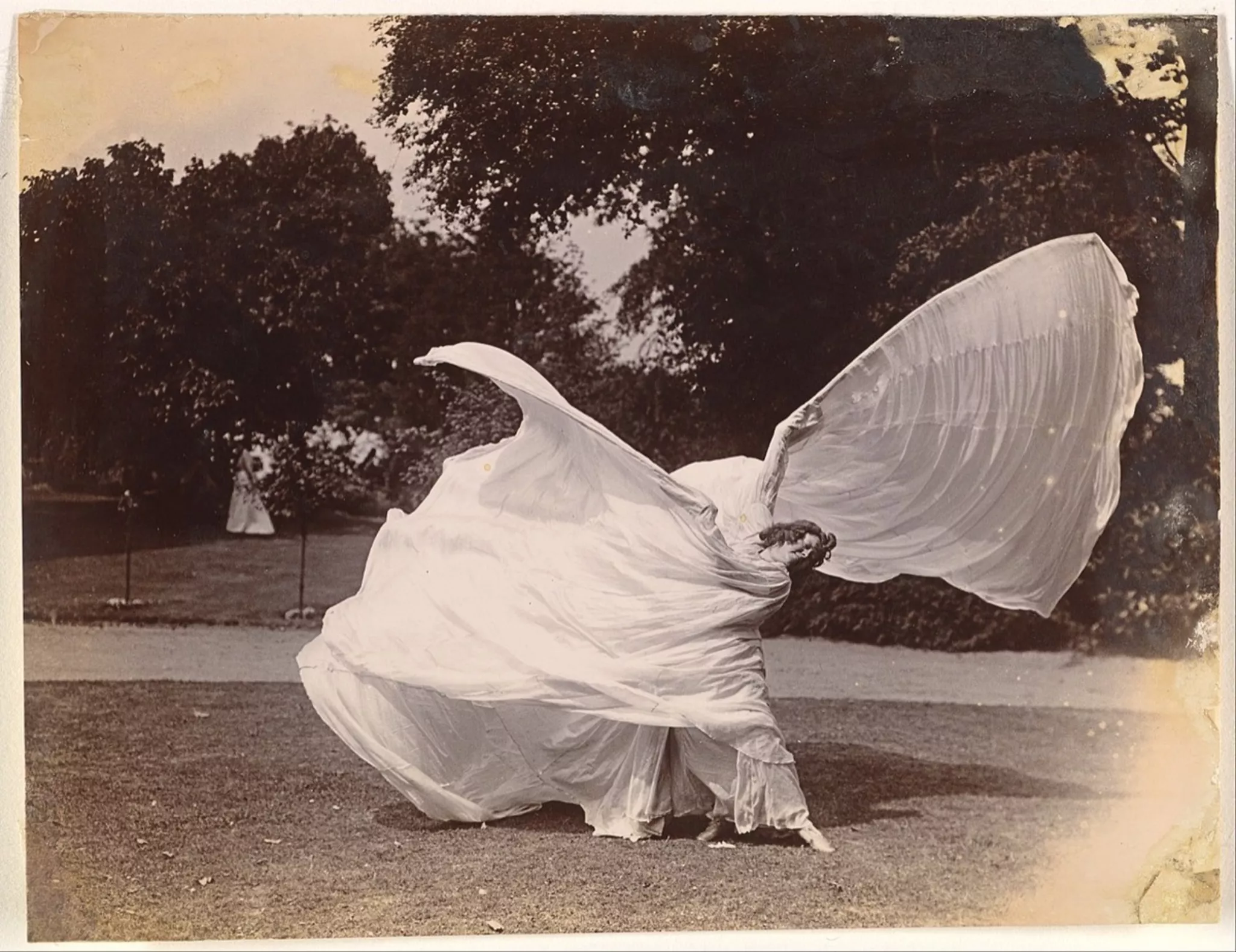
Dance’s potential to become a purely abstract art (vs. a vehicle for storytelling, as in ballet; or a pantomime of sex and seduction, as in music hall performances) seems to have been first realized, Pepe Karmel writes in Abstract Art: A Global History, in the performances of the American dancer Loie Fuller. She dispensed with the narratives of classical dance, and provided a choreographic equivalent to the asbtract forms of music; in doing so she became an international sensation.
Often her costume was a large amount of billowing white silk, which she’d manipulate using rods sewn inside her sleeves. She created shapes that held form momentarily before morphing into something else. Rotating, colored spotlights dyed the silken images various colors; it was a psychedelic performance. Fuller was a dancing lava lamp.
Karmel connects Fuller’s art form to the “pulsating curves” of art nouveau design — which corresponded to the anti-materialist contemporary belief in a mysterious force (what Bergson would later call an élan vital) animating all living creatures in a way that could not be explained by mechanistic biology. However, Karmel says, Fuller’s idea of representing this vital impulse through waving lines was borrowed from the then-new science of electromagnetism, which analyzed light, electricity, and magnetism as waves in the “ether,” an invisible substance filling all of space. If the fundamental properties of the physical world took the form of waves, then Fuller’s performance made these waves visible.

We read in A Cinema of Transformations that Redon’s drawings and paintings were concerned with “making the unreal real and the invisible visible.” Or as Redon himself puts it: “placing the logic of the visible, insofar as is possible, at the service of the invisible.” Which is a perfectly fine way to describe much of Radium Age proto-sf, Radium Age art, and semiotics too.
Like Radium Age proto-sf authors, Redon seeks to create a startling contrast between realistic — even scientific — ratiocination and depictions, on the one hand, and far-out fantastical notions on the other. Redon writes that his work isn’t pure imagination, but imagination depicted via the “attentive reproduction of the objects of external nature in her tiniest, most particular and most accidental aspects.”
Redon was pleased with Remy de Gourmont’s analysis: Redon managed to make visible certain fantastical images derived from Baudelaire and Flaubert, he writes, “only by sacrificing visual logic to imaginative logic.”
In The Dark Side of Nature, Barbara Larson argues that Redon’s work engaged with changes in science, technology and culture. Scientific theories and breakthroughs of the late 19th and early 20th centuries, specifically new technologies for studying microbes, developments in astronomy and the popularization of evolution, Larson notes, were discrediting “the ideas that man was a superior entity and part of a separate creation, that species were immutable, and that the laws of an ordered, regulated universe could easily be observed and understood.” Like scientists of the era, she’d have us understand, Redon “accepted continuous change and uncertainty of end product.” A different conception of the natural world was emerging.
The Black Sun — we read in A Cinema of Transformations — emerges from a context in which “stars could no longer be thought of as glittering ornaments pinned on the ark walls of the firmament, but had to be reconceived as changing, moving, dying, or originating in the ongoing panoramic drama of the cosmos.”
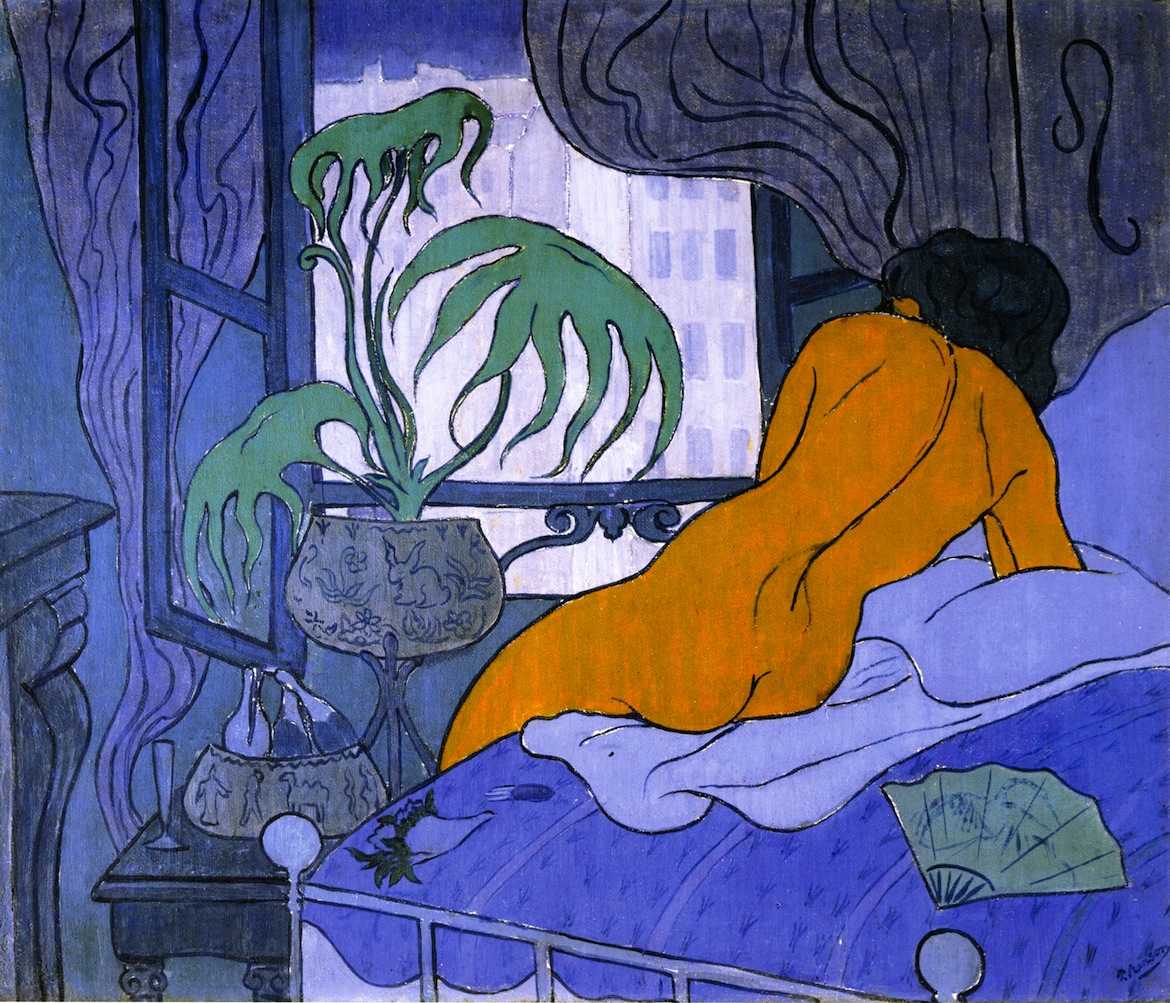
NOTES ON PICTORIAL SYMBOLISM
Symbolism began as a French literary movement in the 1880s — reacting (as the Romantics had, earlier) against the rationalism and materialism that had come to dominate the West. The validity of pure subjectivity, and the expression of an idea over a realistic description of the natural world, was proclaimed. In Stéphane Mallarmé’s words: “To name an object is to suppress three-quarters of the enjoyment to be found in the poem… suggestion, that is the dream.”
The Symbolist movement in literature and the arts is a reactionary one — a reaction against the positivism and utilitarianism of the Enlightenment. Contra the assumptions of progressive, enlightened types, Symbolists insisted that ordinary descriptive language (or artistic depictions) were too mechanical; they failed to convey unique personal feelings and emotions. The poet or artist’s feelings and emotions were, in fact, inexpressible as such; they could only be conveyed suggestively — through association of ideas and carefully constructed imagery. (Something Baudelaire, picking up the idea from Poe and Emerson, had previously claimed.)
Suggestiveness — Symbolist art aims to hypnotize the viewer, to evoke a certain mood.
To me, this is the most fascinating and incisive point to be made about the origins of the “science fiction” genre in the early twentieth century. It evolves out of a hot dilute soup of influences — at least one of which is reactionary, anti-positivistic. Hence all the catastrophes and dystopias. Science fiction evolves as much from a reaction against the techno-optimism of H.G. Wells as it does from Wells. Symbolist art is often pessimistic, bored, alienated… expressing a “cosmic loneliness.”
Symbolism implies a “transcendentalist” worldview. Everything that we perceive is but a shadow or reflection of some imperceptible reality. There is another world, one whose undetectable influences — vibrations, perhaps – help to shape and guide our own. The outward world is a “forest of symbols.” Reality can be perceived neither by the senses nor by the intellect; it can only be revealed to us by the artist or poet.
Moréas’s Symbolist Manifesto (“Le Symbolisme”) of 1886 reads to me like Saussure or Barthes’ Mythologies — it derides “plain meanings, declamations, false sentimentality and matter-of-fact description” as a ruse of the dominant discourse. “Ainsi, dans cet art, les tableaux de la nature, les actions des humains, tous les phénomènes concrets ne sauraient se manifester eux-mêmes; ce sont là des apparences sensibles destinées à représenter leurs affinités ésotériques avec des Idées primordiales.” (Thus, in this art movement, representations of nature, human activities and all real life events don’t stand on their own; they are rather veiled reflections of the senses pointing to archetypal meanings through their esoteric connections.) This is what semioticians will say about representations of nature, human activities, and all real life events — everything is a sign of a concealed meaning. The goal of the semiotician, like that of the Symbolist poet, is to “clothe the Ideal in a perceptible form” whose “goal was not in itself, but whose sole purpose was to express the Ideal” (I’m quoting the manifesto).
In a nutshell, as Mallarmé writes in a letter to his friend Henri Cazalis, the goal of Symbolist poetry and other art forms is “to depict not the thing but the effect it produces.” Semioticians do this in an empirical, painstaking manner. Symbolist poems — by contrast — were attempts to evoke, rather than primarily to describe.
Symbolism was soon identified with the suggestive artwork of a younger generation of painters who were also rejecting the conventions of Naturalism. Though it began in France, Symbolism was an international avant-garde movement that spread across Europe and North America during the last two decades of the nineteenth century. Rather than represent the natural world in an objective, quasi-scientific manner, Symbolist painters held that art should reflect an emotion or idea. The symbolic value or meaning of a work of art stemmed from the re-creation of emotional experiences in the viewer through color, line, and composition. The artist’s inner subjectivity, not an external reality alone, was crucial.
The Symbolists’ rejection of naturalism and narrative in favor of the subjective representation of an idea or emotion would have a significant effect on the artwork of the twentieth century, particularly the formulation of German Expressionism and Abstraction.
Symbolism is a spontaneous revolt against the artificial social and moral values of our fallen civilization — which prides itself on progress and efficiency, which measures every other value against the inhumane standards of positivist science. “We are oppressed by society’s conventions,” insisted the Russian Symbolist (and proto-sf author) Valery Bryusov.
Symbolism is an amoral and apolitical movement, taking its tone from Nietzsche and Baudelaire.
In 1891, Gauguin had been hailed as leader of the Symbolists — because of his simplified and non-naturalistic style. Gauguin’s Vision After the Sermon (1888) was his first intentionally Symbolist picture, one that aimed to synthesize abstracted form with emotional or spiritual experience. Here, Gauguin combined heavily outlined, simplified shapes with solid patches of vivid color to symbolically express the ardent piety of simple Breton women. This painting exerted a tremendous influence on the group of artists known as the Nabis.
Gauguin was the most prominent artist who rejected the attitudes of the Impressionists most violently in the wake of Symbolism. This fervent passage of his is often quoted:
[The Impressionists] studied color, and color alone, as a decorative effect, but they did so without freedom, remaining bound by the shackles of verisimilitude. For them there is no such thing as a landscape that has been dreamed, created from nothing. They looked, and they saw, harmoniously, but
without any goal: they did not build their edifice on any sturdy foundation of reasoning as to why feelings are perceived through color.They focused their efforts around the eye, not in the mysterious center of thought, and from there they slipped into scientific reasons…. Intellect and sweet mystery were neither the pretext nor the conclusions; what they painted was the nightingale’s song…. Dazzled by their first triumph, their vanity made them believe it was the be-all and the end-all. It is they who will be the official painters of tomorrow, far more dangerous than yesterday’s.
He rejected such art as materialist and therefore superficial, without ideas.
In a 1945 lecture, Andre Breton would agree with Gauguin:
Impressionism… repudiated, in fact, the Romantic imagination and all that which painters named with ill-will literature. Indifferent to philosophy and poetry, the Impressionist painters claim to paint only what they see and as they see it…
Impressionist opticality, materialism and “positivism” conflicted with Breton’s validation of a metaphorical and increasingly esoteric content in art. See Breton’s Manifesto of Surrealism, where he conflates positivism with “common sense” and suggests that experience is much more rich, deep, and mysterious than common-sensical positivism will admit: “Under the pretense of civilization and progress, we have managed to banish from the mind everything that may rightly or wrongly be termed superstition, or fancy….”
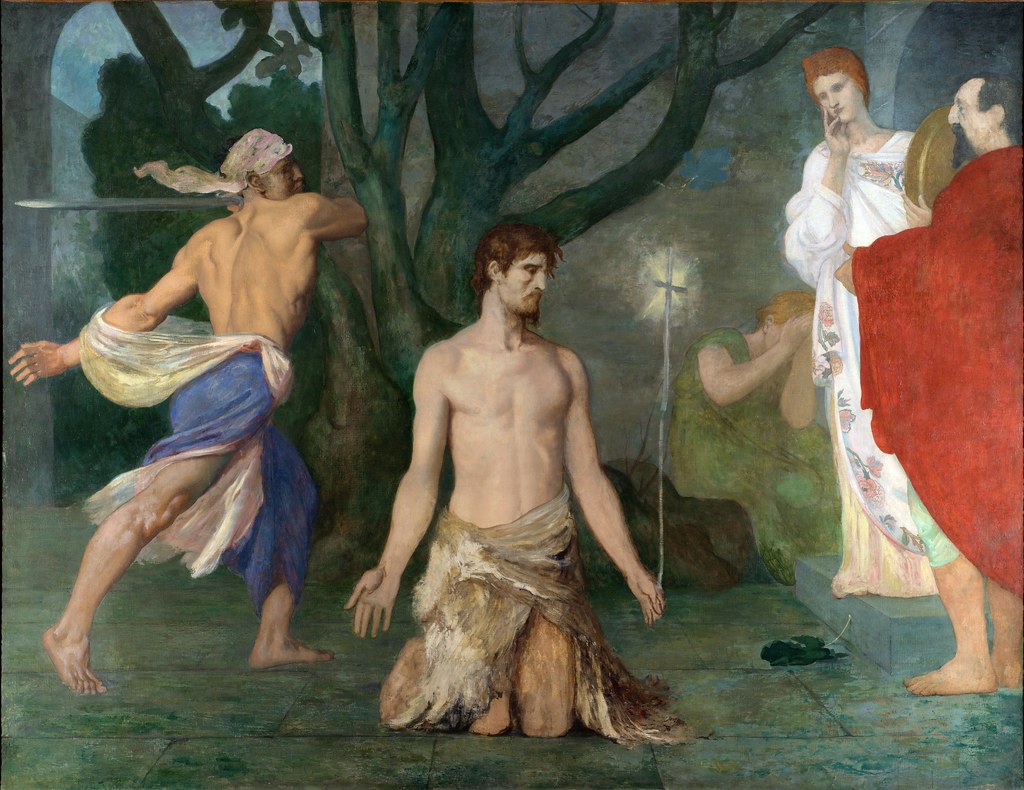
But Gustave Moreau, Puvis de Chavannes (who created greatly simplified forms in order to clearly express abstract ideas), and Edward Burne-Jones (all of whom died before 1900), as well as Redon, Eugène Carrière, and Arnold Böcklin — artists who produced imaginary dream worlds populated with mysterious figures from biblical stories and mythology as well as fantastical creatures — had influenced Gauguin and the Symbolists.
Breton (in Dessins Symbolistes) will describe Moreau as a “great visionary and magician.”
Rather than sharing a single artistic style, the Symbolists were unified by a shared pessimism and weariness of the decadence they perceived in modern society. They sought escape from reality, expressing their personal dreams and visions through color, form, and composition. Their preference for broad strokes of unmodulated color and flat, often abstract forms was inspired by Chavannes.
In 1892, “Sâr” Péladan founded the Salon de la Rose + Croix, inviting artists with strong Symbolist tendencies to exhibit their artwork. Ferdinand Hodler, Jan Toorop, Fernand Khnopff, and others were among the international participants. James Ensor developed a unique Symbolist style based on grotesque and carnivalesque figures. Picasso, an admirer of Gauguin, embraced Symbolism during his formative years in Barcelona. His Blue Period works depict mentally and physically downtrodden characters in the greatly simplified style characteristic of pictorial Symbolism.
In Central Europe, Symbolism witnessed a late flourishing in the works of the Vienna Secession and Gustav Klimt in particular. Klimt’s highly ornamental style reveals the close connection between Symbolism and parallel movements in the decorative arts such as Art Nouveau. (See Munch’s train-smoke painting, above.)
In a nutshell, as Mallarmé writes in a letter to his friend Henri Cazalis, the goal of Symbolist poetry and other art forms is “to depict not the thing but the effect it produces.” Semioticians do this in an empirical, painstaking manner. (Saussure and Peirce agree that the thing itself is outside of language.) Symbolist poems were attempts to evoke, rather than primarily to describe.
During the time of Russia’s spiritual regeneration between the late 1890s and circa 1910, the Symbolist poets and philosophers formulated a vast conglomerate of ideas and ideologies. They explored several areas of intellectual and metaphysical inquiry. Bely, Blok, Ivanov, and Valery Bryusov, for example, were convinced that the phenomenal world covered and concealed the real world (the “substance” or the “essential”). The path of true illumination lay via intuition and cognition, not via objective knowledge.
NOTES ON N-DIMENSIONAL GEOMETRY
“The notion of dimension at first seems intuitive,” writes David S. Richeson.” Glancing out the window we might see a crow sitting atop a cramped flagpole experiencing zero dimensions, a robin on a telephone wire constrained to one, a pigeon on the ground free to move in two and an eagle in the air enjoying three.”
The ancients knew that we live in three dimensions. Aristotle wrote, “Of magnitude that which (extends) one way is a line, that which (extends) two ways is a plane, and that which (extends) three ways a body. And there is no magnitude besides these, because the dimensions are all that there are.”
Yet mathematicians, among others, have enjoyed the mental exercise of imagining more dimensions. What would a fourth dimension ± somehow perpendicular to our three — look like?
One popular approach (see Flatland): Suppose our knowable universe is a two-dimensional plane in three-dimensional space. A solid ball hovering above the plane is invisible to us. But if it falls and contacts the plane, a dot appears. As it continues through the plane, a circular disk grows until it reaches its maximum size. It then shrinks and disappears. It is through these cross sections that we see three dimensional shapes. Similarly, in our familiar three-dimensional universe, if a four-dimensional ball were to pass through it would appear as a point, grow into a solid ball, eventually reach its full radius, then shrink and disappear.
This all adds up to an intuitive understanding that an abstract space is n-dimensional if there are n degrees of freedom within it (as those birds had), or if it requires n coordinates to describe the location of a point. Yet mathematicians discovered that dimension is more complex than these simplistic descriptions imply.
In the late 19th and early 20th centuries, the public became infatuated with the fourth dimension. In 1884, Edwin Abbott wrote the popular satirical novel Flatland, which used two-dimensional beings encountering a character from the third dimension as an analogy to help readers comprehend the fourth dimension. A 1909 Scientific American essay contest entitled “What Is the Fourth Dimension?” received 245 submissions vying for a prize. And many artists, like Picasso and Duchamp, incorporated ideas of the fourth dimension into their work.
PS: The fourth dimension was frequently associated in this period with Kantian philosophy. In his doctrine of transcendental idealism, Kant argued the sum of all objects, the empirical world, is a complex of appearances whose existence and connection occur only in our representations. Kant introduces the thing-in-itself as follows:
And we indeed, rightly considering objects of sense as mere appearances, confess thereby that they are based upon a thing in itself, though we know not this thing as it is in itself, but only know its appearances, viz., the way in which our senses are affected by this unknown something.
See for example May Sinclair’s story in More Voices from the Radium Age.
NOTES ON X-RAYS
Röntgen discovered the mysterious new rays he termed “X-rays” in 1895. Not until 1912 would it be confirmed thay x rays are a form of electromagnetic radiation with a wavelength shorter than visible light or ultraviolet radiation. Röntgen’s publication of his findings at the end of 1895 triggered
“the most immediate and widespread reaction to any scientific discovery before the explosion of the first atomic bomb in 1945” (Henderson). Whereas the philosophical and popular concern with the fourth dimension would emerge gradually during these years (becoming an important driver of Cubist interest i the subject), the discovery of x rays provided an immediate, empirical demonstration of the relativity of human perception. (Unseen Forces, to use the themes found in each of this series’ posts, leap ahead of Fourth Dimension — even though n-dimensional geometry had been formulated decades earlier.)
In an 1896 article, “Professor Roentgen’s Discovery and the Invisible World Around Us,” James Bixby sounded what would become a recurrent theme in the literature on x rays: “The more carefully science examines the senses, the more surely it demonstrates their limitations and of how small a part of the universe these fleshly organs can catch a glimpse.” (Quoted by Henderson).
Linda Dalrymple Henderson suggests that an analysis of the images, concepts, and individuals associated with x-rays and radioactivity allow us to fathom “the enormous impact of these invisible rays which clearly established the inadequacy of human sense perception and raised fundamental questions about the nature of matter itself.”
Henderson: “The extrasensory reality revealed by x-rays pointed to … the inadequacy of human sense perception.” That x rays should have interested artists seeking to move beyond Impressionism’s devotion to visual sensation, she writes, is snot surprising. “Röntgen’s discovery dealt a powerful blow to traditional sense-oriented positivism and to materialism in general.”
For example, let’s try visualizing the four-dimensional equivalent of a cube, known as a tesseract, by building up to it. If we begin with a point (0 dimensions), we can sweep it in one direction to obtain a line segment (1 dimension). When we sweep the segment in a perpendicular direction, we obtain a square (2 dimensions). Dragging this square in a third perpendicular direction yields a cube (three dimensions). Likewise, we obtain a tesseract by sweeping the cube in a fourth direction (four dimensions).
NOTES ON OCCULTISM’S INFLUENCE ON MODERN ART
The underlying precepts of occult thought — and the geometrizing signs and diagrams with which they were often illustrated in esoteric texts — gradually became widely known in late 19th-century artistic circles. By the early 20th century occultism was of fundamental importance to a number of artists who practiced some form of what is called abstract art. Their involvement with the “sacred geometries” of occult tradition were means by which the spiritual content could be retained in their art. The trend was away from a residual naturalism toward ever more reductive forms of abstraction; for Kupka, Mondrian, Malevich, Kandinsky and others the purification of natural into abstract forms implied the proposition that geometric configurations function as paradigms of spiritual enlightenment.
See: Richard Noakes, “Physics and Psychics: The Occult and the Sciences in Modern Britain” (January 2021, Social History of Medicine). According to Robert Brain, “Noakes offers a historically sensitive reconstruction of the conditions that made physics important to spiritualists and psychical researchers, and spiritualism and psychic phenomena significant to physicists.”
See: Useful review of Michael Gibson’s Symbolism (1995).
See Alex Owen’s The Place of Enchantment: British Occultism and the Culture of the Modern (2004).
See Linda Dalrymple’s “Editor’s Statement: Mysticism and Occultism in Modern Art” (Spring 1987 issue of Art Journal).
FURTHER NOTES ON THIS TOPIC CROSS-POSTED FROM RADIUM AGE: TIMELINE (1900)
One of the goals of this series is to trace the influence of occult and mystical thought and practice of the era on the emerging sf genre. So a definition: “Mysticism” refers to the search for a state of oneness with ultimate reality. “Occultism” depends upon secret, concealed phenomena — not readily available to ordinary understanding or scientific reason — that are accessible only to those who have been appropriately initiated. Mystical-occult beliefs, transmitted through books and pamphlets featuring diagrams and illustrations that would influence the emergence of abstract art, include such ideas as: the universe is a single, living substance; mind and matter are one; all things evolve in dialectical opposition (light-dark, positive-negative, male-female, etc.), things “above” are analogous to things “below,” etc.
This idea can be traced to Charles F. Dupuis, minister of education during France’s First Republic, and a scholar of comparative religion whose multivolume Origine de tous les cultes ou religion universelle was published in 1794. He emphasized Egypt as a fountainhead of religious knowledge, and asserted that all ancient sacred mythologies embodied heaven-and-earth, sun-and-moon, male-and-female dualities. He didn’t accept their occult reality, but acknowledged these basic components of mystical iconography. Later occultists and mystics — particularly Blavatsky and the Theosophists — would get a lot of use out of this notion. Another important text was the 1818 book Symbolical Language of Ancient Art and Mythology by Richard Payne Knight, from which Blavatsky and the Theosophists got their fascination with certain geometric forms — the tau cross, the triangle, etc. 19th century occult texts were replete with diagrams made up of easily readable geometric shapes — this was the true beginning of the infographic revolution. (Look at any book about the history of data visualization, and you will find so much occult stuff. I’m thinking of, say, Manuel Lima’s The Book of Circles.) Blavatsky’s The Secret Doctrine (1888) spends page after page unpacking the esoteric meanings of the cross and the circle’ squares and triangles she unpacks in other writings. Indeed, Blavatsky was a major synthesizer of geometric symbol systems.
Why did mystical-occult thought and practice grow so popular during the 19th century? One compelling theory is that the industrial revolution and its effects on not only the economy but society and culture, coupled with the findings of Darwin and other scientists (including the first law of thermodynamics), led to the perception of life as barren and devoid of meaning. Positivist and materialist philosophies could not explain existence or provide a comforting faith in life after death; but theosophists, magicians, and mystics of the 19th century could and did. See Jennifer Wallters’ thesis “Magical Revival.”
Theosophy offered a de-Christianized, mystical experience of spiritual rebirth. Darwinism (anathema to traditional Christianity) provided spiritualism with its central concept: evolution. However, where Darwinian evolution depended on the competitive process of natural selection, spiritual evolution was seen as a peaceful, teleological process. Not proto-sf’s fascination with Lamarckian, teleological evolution…
There is a certain anti-positivism running through proto-sf. For example: Arthur Conan Doyle.
Also in 1900: Having been ejected from the Theosophical society for his magical experiments, William Butler Yeats joined the Hermetic Order of the Golden Dawn. (At various times, the order included writers Arthur Machen and Bram Stoker, the Irish revolutionary Maud Gonne, and the magicians Arthur Edward Waite and Aleister Crowley.) When Crowley showed a tendency to use his occult powers for personal gain rather than for good, the adepts of the order, Yeats among them, decided not to allow him to be initiated into the inner circle. This led to a Yeats-Crowley wizard battle in 1900, aka the Battle of Blythe Road.
In some of the spiritual movements with which this series will be concerned, there was an important crossover between metaphysical ideas and new advances in science (particularly physics and chemistry; n-dimensional geometry, the properties of time and space). Scientific advances allowed metaphysical thinkers to speculate about invisible aspects of the material universe… and to confirm their own beliefs.
Popularized beliefs about n-dimensional geometry (more than three dimensions) were essential for the Russian Futurist movement and the art of Malevich. Ouspensky would unite properties of time and space in the concept of a fourth dimension.
French mathematician Maurice Princet was known as “le mathématicien du cubisme” (“the mathematician of cubism”). An associate of the School of Paris—a group of avant-gardists including Pablo Picasso, Guillaume Apollinaire, Max Jacob, Jean Metzinger, and Marcel Duchamp—Princet is credited with introducing the work of Henri Poincaré and the concept of the “fourth dimension” to the cubists at the Bateau-Lavoir during the first decade of the 20th century.
See Tom H. Gibbons’s “Cubism and ‘The Fourth Dimension’ in the Context of the Late Nineteenth-Century and Early Twentieth-Century Revival of Occult Idealism” (1981).
The eighteenth and nineteenth centuries also bequeathed to the 1900–1935 era a fascination with energy flows and vibrations pervading the material world. Baudelaire, for example, had noted that “the more vigilant senses perceive more reverberating sensations.” Many mystical-occult writers were also fascinated with synaesthesia, and with sacred geometry — publishing intricate charts and diagrams — a tradition at least as old as Kircher’s 1678 chart Magnetismus Globorum Astralium or Böhme’s 1764 chart The True Principles of All Things. (Schlegel: “A philosophical work must have a definite geometrical form.”) Because the complexities and abstract truths expressed by geometrical form could only be explained as reflections of the innermost truths of the world’s being, they were held to be sacred mysteries. Art not only as a vehicle of aesthetic satisfaction but also as a conduit between the microcosm of earthly existence and the macrocosm of everlasting spiritual existence.
The positivistic intuition — that science concerns the logical extraction of laws and predictive consequences from verifiable sense data; that science makes no metaphysical leaps, but is instead a way of putting ourselves in a situation where hypotheses can be confirmed or rejected on the basis of procedures that keep one firmly anchored to physical facts and the unbiased analysis thereof — was wearing thin, at this point. As the philosopher E A. Burtt would put it, in The Metaphysical Foundations of Modern Physical Science (1924/1925), a critique of logical positivism that would influence the historian and philosopher of science Alexandre Koyré, and through Koyré the philosopher of science Thomas Kuhn, there is “no escape from metaphysics.” That is, science must account for subjective perspectives, since all objective conclusions are ultimately founded upon the subjective conditioning/worldview of its researchers and participants.
We have never been modern, as Bruno Latour puts it. Although we’ve been led to believe that the defining feature of modernity is that people no longer believe in spirits, myths, or magic, even the human sciences have been more enchanted than is commonly supposed. Philosophy, anthropology, sociology, psychoanalysis, religious studies, folklore and other disciplines contributed to the myth of disenchantment — the myth of mythless modernity — but many of these disciplines’ founding figures were not only aware of, but profoundly enmeshed in, the occult and spiritualist revivals taking place in Britain, France, and Germany; according to Jason Ananda Josephson Storm’s The Myth of Disenchantment: Magic, Modernity, and the Birth of the Human Sciences, for example, it was specifically in response to this burgeoning culture of spirits and magic that they produced notions of a disenchanted world.
T.J. Jackson Lears’s No Place of Grace: Antimodernism and the Transformation of American Culture, 1880–1920 helps contextualize (though he never mentions sf) the emergence of sf. Modernism was regarded by many brilliant thinkers and artists of the era — including William James — as something to be fought because it was synonymous with the loss of inner spiritual values. James emphasized that the only way to attain higher consciousness was to free oneself from the confines of selfhood. He was interested in how sensory, symbolic elements played an enormous part in mysticism.

The underlying precepts of occult thought and the geometrizing signs and diagrams with which they were often illustrated in esoteric texts gradually became widely known in late 19th-century artistic circles. By the early 20th century occultism was of fundamental importance to a number of artists who practiced some form of what is called abstract art. Their involvement with the sacred geometries of occult tradition were means by which the spiritual content could be retained in their art. The trend was away from a residual naturalism toward ever more reductive forms of abstraction; for Kupka, Mondrian, Malevich, Kandinsky and others the purification of natural into abstract forms implied the proposition that geometric configurations function as paradigms of spiritual enlightenment.
Michael H. Whitworth (author of Einstein’s Wake) suggests that the fragmentary nature of modernist poetic form — Pound, Eliot, et al. — “seems to stand in some sort of connection to the science of the late nineteenth and early twentieth centuries.” How so? Because the themes of modern physics were those of “disintegration, violence, and derangement.” (He is quoting historian of science Gerald Holton’s Thematic Origins of Scientific Thought (1973).
Alan J Friedman and Carol C. Donley’s Einstein as Myth and Muse: “Twentieth-century physics postulated and experimentally validated two new world views, relativity theory and quantum theory, which differed from the conventional so fundamentally that philosophers and artists were encouraged to assimilate similar revolutionary views into their own disciplines. Modern painting, for example, developed a new spatial ordering. The new world views opened a huge realm of unexplored possibilities and demanded a change in our imaginative picture of the world.
Artists in all fields welcomed this opportunity, studied the new ideas, and experimented with art forms consonant with their time. Wyndham Lewis points out that the experiments involved ‘not only technical and novel combinations, but also the essentially new and particular mind that must underlie, and should even precede, the new and particular form, to make it viable.'”
Also:
“Many artists contemporary with physicists Albert Einstein, Werner Heisenberg, and Niels Bohr found that conventional forms were inadequate in the context of the new physical understandings. New forms had to be created in order to give shape to the new ideas, and the new forms in one discipline often paralleled those in others. Thus as four-dimensional geometries appeared in mathematics and physics, treating time as a dimension equivalent to those of space, the traditional three-dimensional representation in art expanded to include temporal dimension in avant-garde painting. The arts became concerned with time as a dimension and with space-time relationships. Physicists found there was no universal frame of reference, and multiple viewpoints showed up on paintings and in novels. Physicists indicated that the flux of a field represented the strength of its source, and artists began inventing their own “field” forms. Relationships between objects became more important than the objects themselves. When physicists discovered they could not simultaneously find a particle’s exact position and exact momentum, they admitted the basic indeterminism inherent in the quantum theory, which gives a probabilistic rather than a causal description of nature: In literature conventional consecutive plots often disappeared and standard syntactical relationships were fractured.”
NOTES ON RADIOACTIVITY
The early 1900s was a period of intense interest in radioactivity. The phenomenon was discovered in 1896 by Parisian researcher Henri Becquerel, who specialized in the study of phosphorescence and fluorescence. Wondering if such “glow in the dark” materials might give off X-rays, which had themselves only been discovered the year earlier, he wrapped photographic plates in black paper, placed a sample of phosphorescent uranium potassium sulfate on top of it, and placed it in the sunlight. As he’d hypotheized, the photographic plates were darkened, suggesting the presence of X-rays. When poor weather forced him to put his experiments on hold, however, he found that the uranium still darkened the photographic plates, suggesting the presence of some sort of inherent radiation coming from the uranium itself.
Becquerel’s discovery didn’t attract much attention at first, being overshadowed by the more sensational properties of X-rays. This changed with the investigations of Marie Curie. Around 1898, she demonstrated that the known element thorium was also radioactive, and in the same year she and her husband Pierre crushed hundreds of kilograms of uranium ore to isolate a new radioactive element, which they named polonium. Their investigations suggested an even more radioactive element in even smaller quantities, and within a year they had proven the existence of the highly radioactive radium — though it took until 1902 to collect even a tenth of a gram of this new substance.
NOTES ON EXPRESSIONISM
Expressionist painters explored the bold use of paint surface, drawing distortions and exaggerations, and intense color.
Expressionism was developed as an avant-garde style before the First World War. It remained popular during the Weimar Republic, particularly in Berlin. The style extended to a wide range of the arts, including expressionist architecture, painting, literature, theater, dance, film, music. While the word expressionist was used in the modern sense as early as 1850, its origin is sometimes traced to paintings exhibited in 1901 in Paris by the otherwise obscure artist Julien–Auguste Hervé; he called his exhibit Expressionismes.
Until c. 1910 the word “Expressionism” would be used in a loose way to refer to various pan-European avant-garde tendencies, including Fauvism, Cubism, Orphism, and Futurism, as well as the art of the Brücke and Blaue Reiter groups, as a way of differentiating them from Impressionism or Naturalism, which were still prevalent styles. Where “Impressionism” was understood to concern the effects of light, and “Naturalism” the observable world, “Expressionism” connoted an emphasis on personal expression and essential form.
The movement developed in the early twentieth century in reaction to the dehumanizing effect of industrialization and the growth of cities. It is an avant-garde movement — that is to say, an art movement marking its distance to traditions and the cultural institution as a whole — through its relationship to the then-dominant (realist) conventions of representation.
The Expressionist emphasis on individual perspective has been characterized as a reaction to scientific positivism and other artistic styles such as Naturalism and Impressionism. Note that art historians have often linked Impressionist painting with positivism — the dominant philosophy of the third quarter of the nineteenth century. (Baudelaire was an anti-positivist.) Breton in Surrealism and Painting (1958), quoting another critic on Impressionism: “It is a question of painting humbly, stupidly, the plays of light which pass before the artist’s eyes.”
However, “positivism” doesn’t necessarily entail an art of simple observation or realism; the Impressionists did not aim to be merely impassive recorders of empirical phenomena.
Clement Greenberg, who wished to strip modern art of any religious, philosophical, or occultist vestiges, (approvingly) on the Impressionists, in 1947:
The Impressionists and those who came after them in France put themselves in accord with the situation [created by ‘bourgeois industrialism’] by implicitly accepting its materialism the fact, that is, that modern life can be radically confronted, understood and dealt with only in material terms…. From now on you had nothing to go on but your states of mind and your naked sensations, of which structural, but not religious, metaphysical or historico-philosophical, interpretations were alone permissible. It is its materialism, or positivism that made painting the most advanced and hopeful art in the West between 1860 and 1914 … The School of Paris rested on a sufficient acceptance of the world as it must be, and it delighted in the world’s very disenchantment, seeing it as evidence of man’s triumph over it.
Note parallel between Greenberg and John W. Campbell Jr., and other editors and writers of science fiction’s so-called “Golden Age,” who were carrying out a similar operation in the field of sf. Stripping it of its early twentieth-century weirdness.
The Expressionist artist strives to convey their personal feelings about the object painted, rather than merely record their observation of it. Thus, representational accuracy is sacrificed / distorted in favor of — say — strong outlines and bold colors.
It’s a style of art, rather than a movement; cave paintings — with their strong outlines and bold colors — are expressionist. As an art movement, Expressionism emerged in the late-19th and early-20th century, mainly in Germany and Paris, as a reaction to the more passive style of Impressionism (also an avant-garde movement of sorts, but one that sought to reproduce the effects of sunlight accurately — “passively,” without introducing the artists’ feelings).
One reads of Expressionism that its defining elements include:
- aspiration towards the ideal; cosmic, metaphysical yearnings
- rejection of art that aims to capture the factual, logical realities of life, in favor of a search for a spiritual reality
- a search for the original, the uncreated
- a return to the primordial, to the origins, to the mythical universe
- excess of color; strident, contrasting chromatics; broken lines and curves.
Van Gogh (who distorted form and color to express his intense feelings), Gauguin (whose use of color set him apart), and Munch are the pioneers of expressionism during this era. Also the Swiss Symbolist painter Hodler and the Symbolist Ensor.
PROLEPTIC NOTES ON ABSTRACT ART
“The abstract picture bears traces of signals that have come from far away.” — Alberto Magnelli
Western art had been, from the Renaissance up to the middle of the 19th century, underpinned by the logic of perspective and an attempt to reproduce an illusion of visible reality. By the end of the 19th century many artists felt a need to create a new kind of art which would encompass the fundamental changes taking place in technology, science and philosophy. Abstract art (near-synonyms include: non-figurative, non-objective, non-representational) uses shape, form, color and line to create a composition that may exist with a degree of independence from visual references in the world.
NOTES ON MICROBES
“In the wake of the industrial revolution, late-19th-century architects and designers wanted to create a new style—an Art Nouveau—and like architects of the past, they turned to nature for inspiration. But unlike their predecessors, Victor Horta in Brussels and Louis Sullivan in America knew leaves and flowers down to the cellular level. Thus they abstracted from the substructure of nature a new design vocabulary of biomorphic forms—curved, flat shapes, as in a stained, transparent slice of tissue prepared between glass plates for viewing with a microscope.” — Lynn Gamwell, Beyond the Visible–Microscopy, Nature, and Art (2003).
NOTES ON CHRONOPHOTOGRAPHY
The connection between psychic and x-ray photography was personified in Albert Londe, remembered for his work as a medical photographer at the Salpêtrière Hospital in Paris. He was arguably the most outstanding scientific photographer of his time. Londe was a major pioneer of x-ray photography in France, and his x-ray images were widely reproduced. Chronophotography was another of Londe’s pursuits. (He developed a camera with twelve lenses for photographing movement.)
Chronophotography interested Kupka, Duchamp, and the Italian Futurists — because the invisible reality it revealed was one in flux. “Such a dynamic conception of reality was encouraged in this era not only by Henri Bergson’s antimaterialist philosophy of “becoming,” but also by developments in physics following Becquerel’s discovery of the radioactivity of certain substances in 1896. […] After Pierre and Marie Curie’s isolation in 1898 of two new radioactive elements, polonium and radium, and Ernest Rutherford’s formulation of the theory of radioactive decay in 1902-3, radioactivity caught the attention of the general public. Suddenly, in addition to x rays and cathode rays, there were new, invisible alpha, beta, and gamma rays produced by radioactive materials.” (Linda Dalrymple Henderson)
ALSO
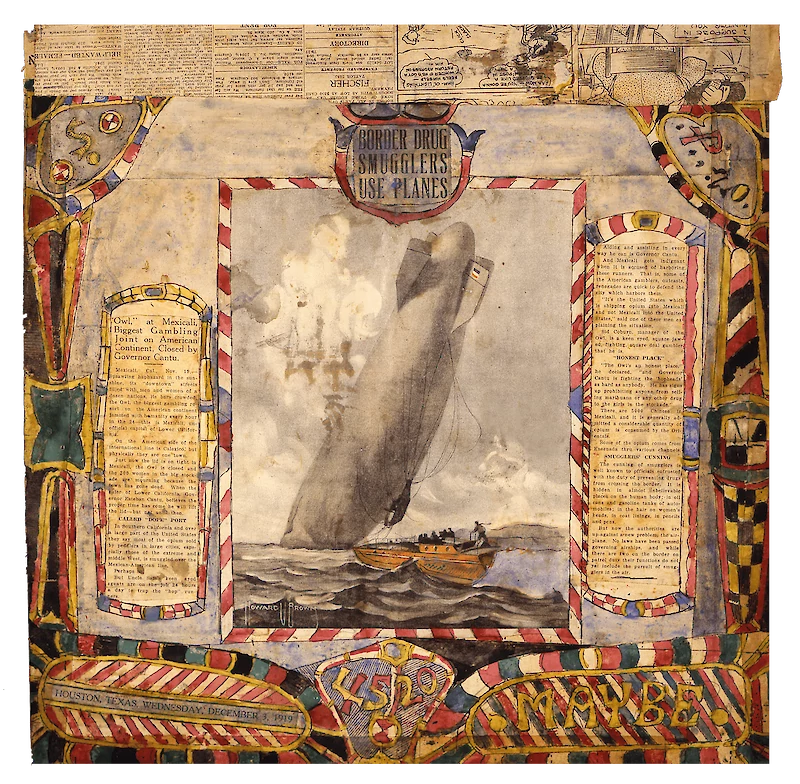
Born in Berlin in 1830, Dellschau immigrated to the United States at age 19 and worked as a butcher near Houston Texas. He married a widow, raised three children, and served in the Confederate army during the American Civil War. After his wife and son died in 1877, Dellschau worked as a clerk for his son-in-law’s saddlery until his death in 1923. 40 years laters, a junk dealer uncovered 12 notebooks, bound with shoelaces, from a trash heap outside the Dellschau family home. The notebooks changed hands a few times, eventually winding up in the care of art history student Mary Jane Victor.
The 12 notebooks were created by Charles Dellschau between 1908 and 1921, and document the invention of an anti-gravity fuel called NB Gas by a secret society of aviators called the Sonora Aero Club.
MORE RADIUM AGE SCI FI ON HILOBROW: RADIUM AGE SERIES from THE MIT PRESS: In-depth info on each book in the series; a sneak peek at what’s coming in the months ahead; the secret identity of the series’ advisory panel; and more. | RADIUM AGE: TIMELINE: Notes on proto-sf publications and related events from 1900–1935. | RADIUM AGE POETRY: Proto-sf and science-related poetry from 1900–1935. | RADIUM AGE 100: A list (now somewhat outdated) of Josh’s 100 favorite proto-sf novels from the genre’s emergent Radium Age | SISTERS OF THE RADIUM AGE: A resource compiled by Lisa Yaszek.


